American Indian Jewelry
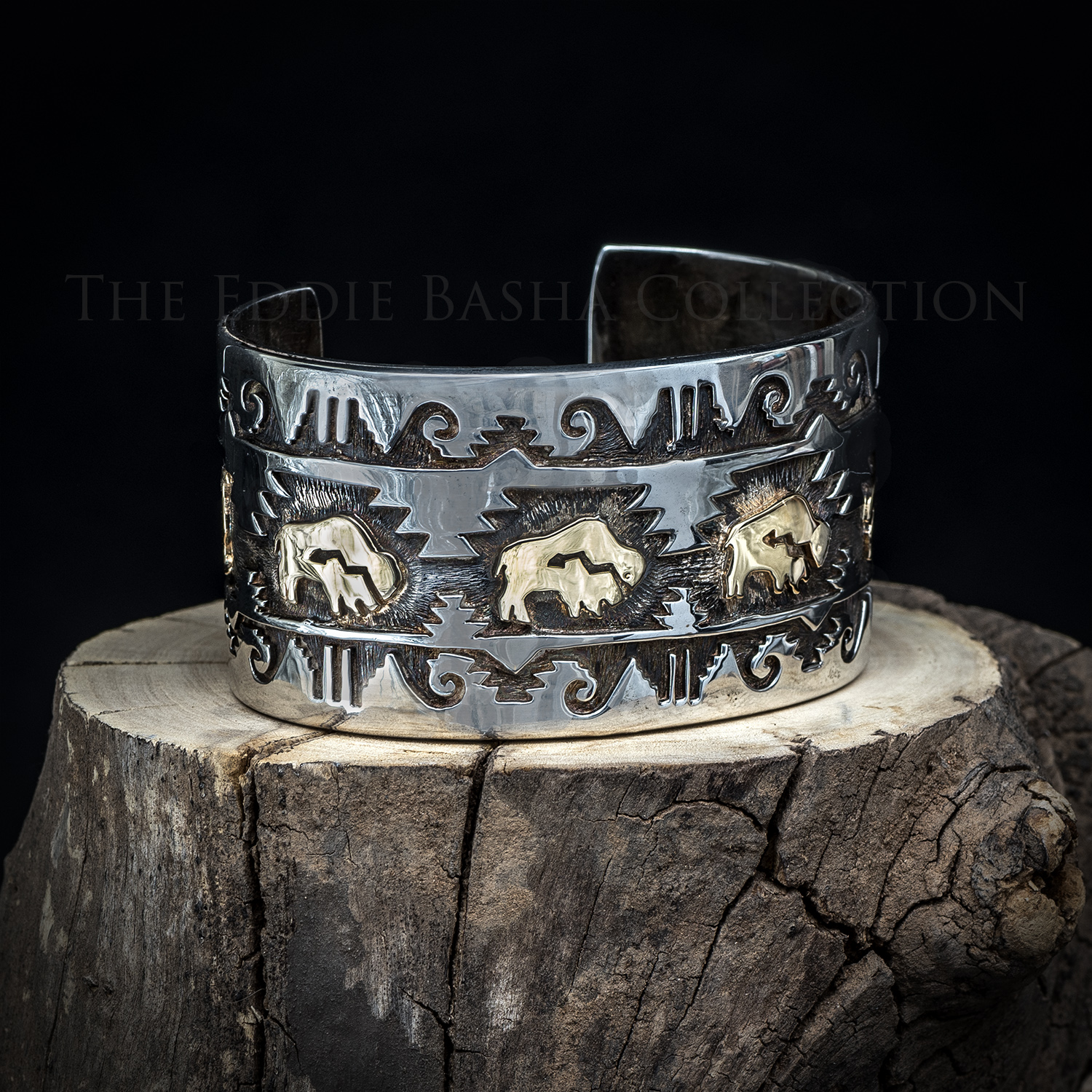
Untitled | Dina Huntinghorse (b.1962)
Artist: Jewelry
Description: Silver & Gold Pictoral Cuffjewelry
Wichita jewelry designer Dina Huntinghorse incorporates a blend of traditional and contemporary jewelry techniques to create masterful works of wearable art. Although gold and silver work are rarely seen among the tribes of the Great Plains, Dina's life experiences introduced her to the craft, and inspired her to develop her own unique style.
Raised in southwestern Oklahoma, Dina's first love was of horses, and she learned to reproduce their likeness in pencil sketches and paintings. She was later taught the traditional art of beadwork by an aunt and became known for her beaded deerskin purses. In 1989, her interest in jewelry was piqued when her late husband, Navajo jeweler Herbert Taylor, taught her to cut beads and do inlay work. Dina began making jewelry on her own in 1996. Her work is featured in galleries throughout the southwest, and she is a regular participant at the Heard Museum and Santa Fe Indian Markets.
Along with her respect for the horse, Dina is also known for her affection for the wolf. Through many of her designs, Dina honors her tribal teachings of the wolf's legendary hunting abilities and their human-like regard for the family, or pack.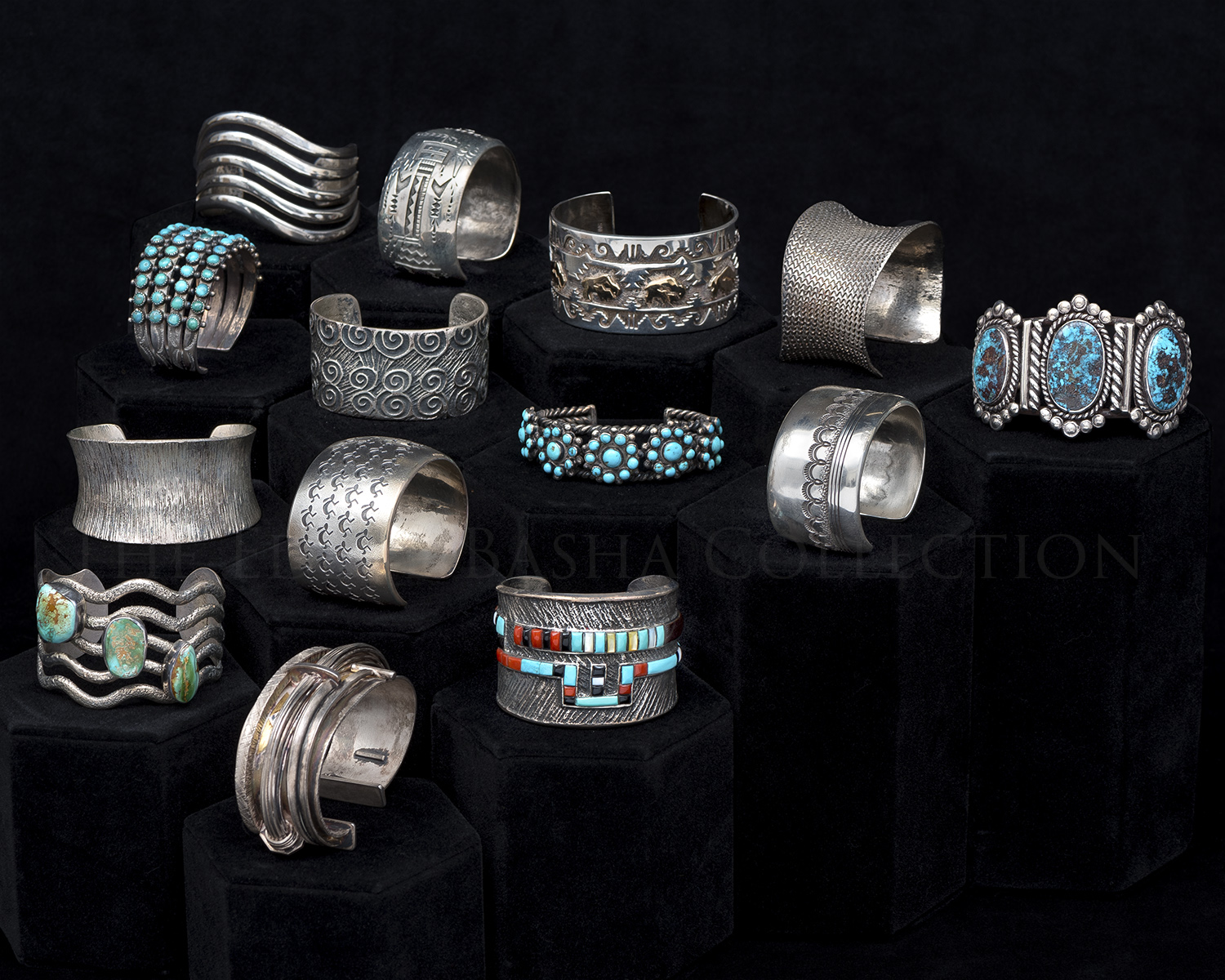
Silver Bracelets | Assorted Artists/Some Unknown: Kay Begay, Norbert Peshlakai, Cheyenne Harris
Artist: Jewelry
Description: Silver, Gold, Turquoise, Coral, Mother of Pearl, and Jetjewelry
“The Navajo silver bracelet passed from hand to hand, wrist to wrist, generation to generation; silversmith to mother, mother to daughter, daughter to medicine man and medicine man to the needy. It passed to a trader in Gallup, ended up as dead pawn, was purchased by a Navajo man, given to a young Australian woman, flown across an ocean, stored in a jewelry box, carried up a mountain and then, as if by magic, found its way home again. Each Navajo silver bracelet has a history.” Quote Source: Perry Null Trading Company
Are you aware of the history (or story) attached to your bracelet?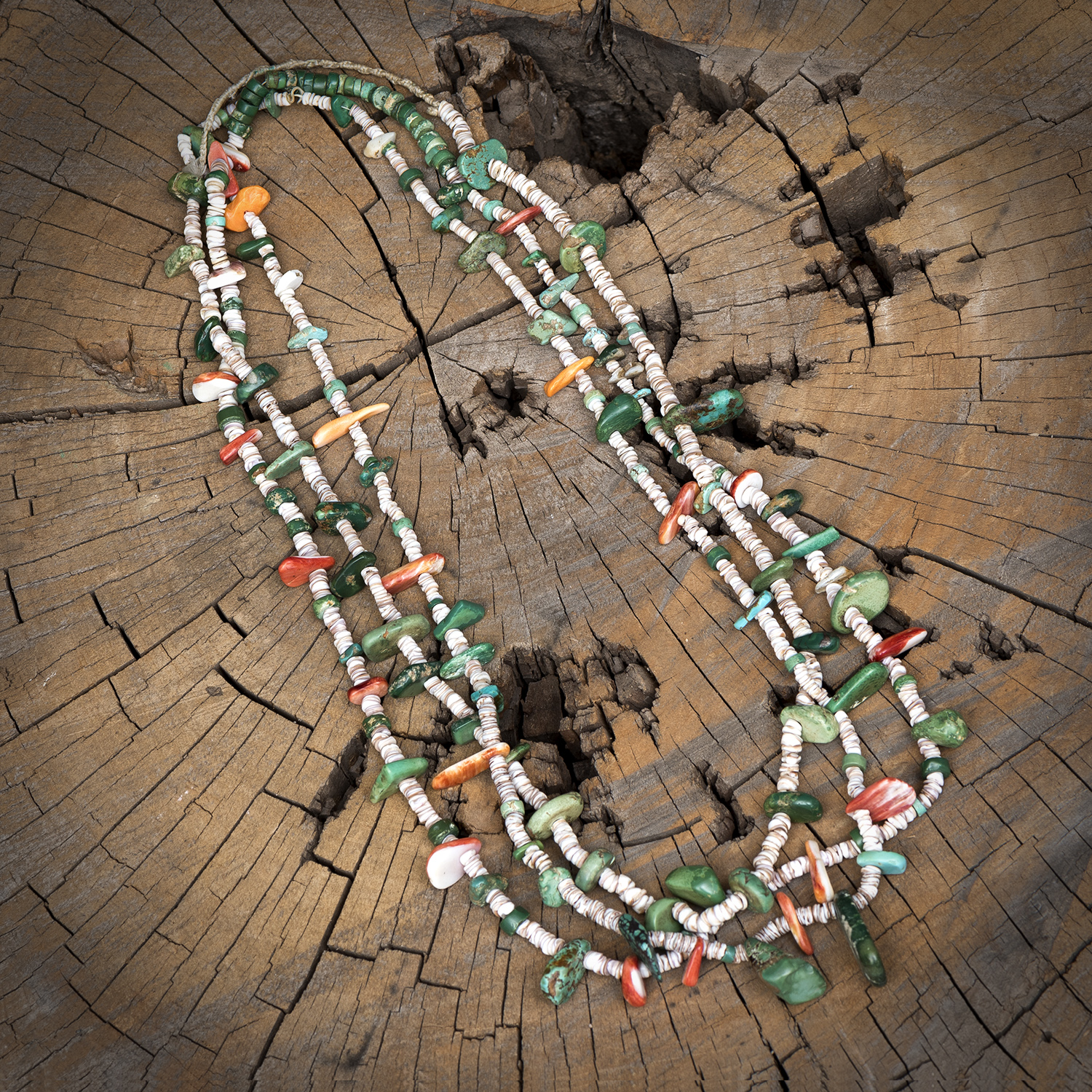
Vintage Heishe Necklace | Unknown Artist
Artist: Jewelry
Description: Heishe, Turquoise & Spiney Oysterjewelry
To borrow the phrase, “we’ve come a long way baby” just might be an understatement. The evolution of handcrafted items has been nothing short of miraculous. Just think of how far mankind has evolved since its early use of stones as tools. Whether out of necessity, cultural practice or simply for living in beauty, throughout time there has been one constant … we look to the past to create for the present. What’s old is new again!
Squash Blossom | Unknown Artist
Artist: Jewelry
Description: Silver & Turquoise | Dimensions: 33”jewelry
In the March 2021 edition of the Santa Fean Magazine, Rosemary Diaz wrote the following about the origins of the Squash Blossom necklace. “The distinguishing feature of the squash blossom necklace is the crescent-shaped pendant lying at its center, known as the naja. While this crescent-shaped symbol is believed to have originated in the ancient Middle East as a talisman worn to ward off evil, it would be the Spanish who brought it to what is now the American Southwest. In the late 1500s and early 1600s, these pendants were worn as iron ornaments on Spanish conquistadores’ leather horse bridles. Traded or acquired from captured horses, these ornaments soon adorned the necks of the local Native populace. When silver beading came into vogue in the late 1800s, Navajos (Diné) began displaying naja pendants on necklaces strung with small, silver beads.
Squash blossom imagery can be found in petroglyphs that pre-date European arrival in the Southwest, but this imagery did not appear in necklace form until after the Native people of the area came into contact with the Spanish. The squash blossom as a design concept originated with the Navajo. They were the first Southwest tribe to utilize the design of the edible gourd, an important source of sustenance. By the early 1900s, the symbol had traveled to the Zuni pueblo and others along the Rio Grande.
The name of the necklace comes from the tri-petal bead, the “blossom,” developed by Navajo silversmiths, who called it “yo ne maze disya gi,” or “bead that spreads out.” But the classic squash blossom necklace is actually comprised of three distinct components: the plain, unembellished round beads, round beads embellished with blooming petals and the naja centerpiece. The squash blossom as a design concept originated with the Navajo. They were the first Southwest tribe to utilize the design of the edible gourd, an important source of sustenance.
The naja is also representative of the womb; a single nugget of turquoise suspended from the pendant symbolizes a child growing within. And though the squash blossom necklace to which it is attached has no specific ceremonial function among Southwest tribes, it was traditionally worn as a symbol of one’s status, wealth and cultural belonging.
Some believe the squash blossom was taken from the pomegranate-shaped decorations found on the buttons of Spanish soldiers. Others assert that the squash blossom is just that — an homage to one of the most important foods of the early Southwest Native diet. Along with beans and corn, squash is one of the Three Sisters. This trio of crops share a symbiotic relationship when planted together and have provided sustenance to Indigenous peoples of the high desert for centuries. Origins aside, one thing is clear: the squash blossom represents a centuries-old fusion of cultures and design.
Early “First Phase” Native silversmithing, an era from 1860-1900, produced rustic, handmade squash blossom necklaces. The najas were pure silver, often cast in a type of limestone known as tufa. Later, necklaces were set with turquoise petit point and needlepoint inlay, techniques most commonly attributed to the Zuni. Many exquisite, highly collectable pieces can be found among old pawn jewelry offered by shops and galleries, as well as at estate sales. In recent years, many older pieces have been recycled into new works, a reflection of soaring prices for silver and high-quality turquoise.”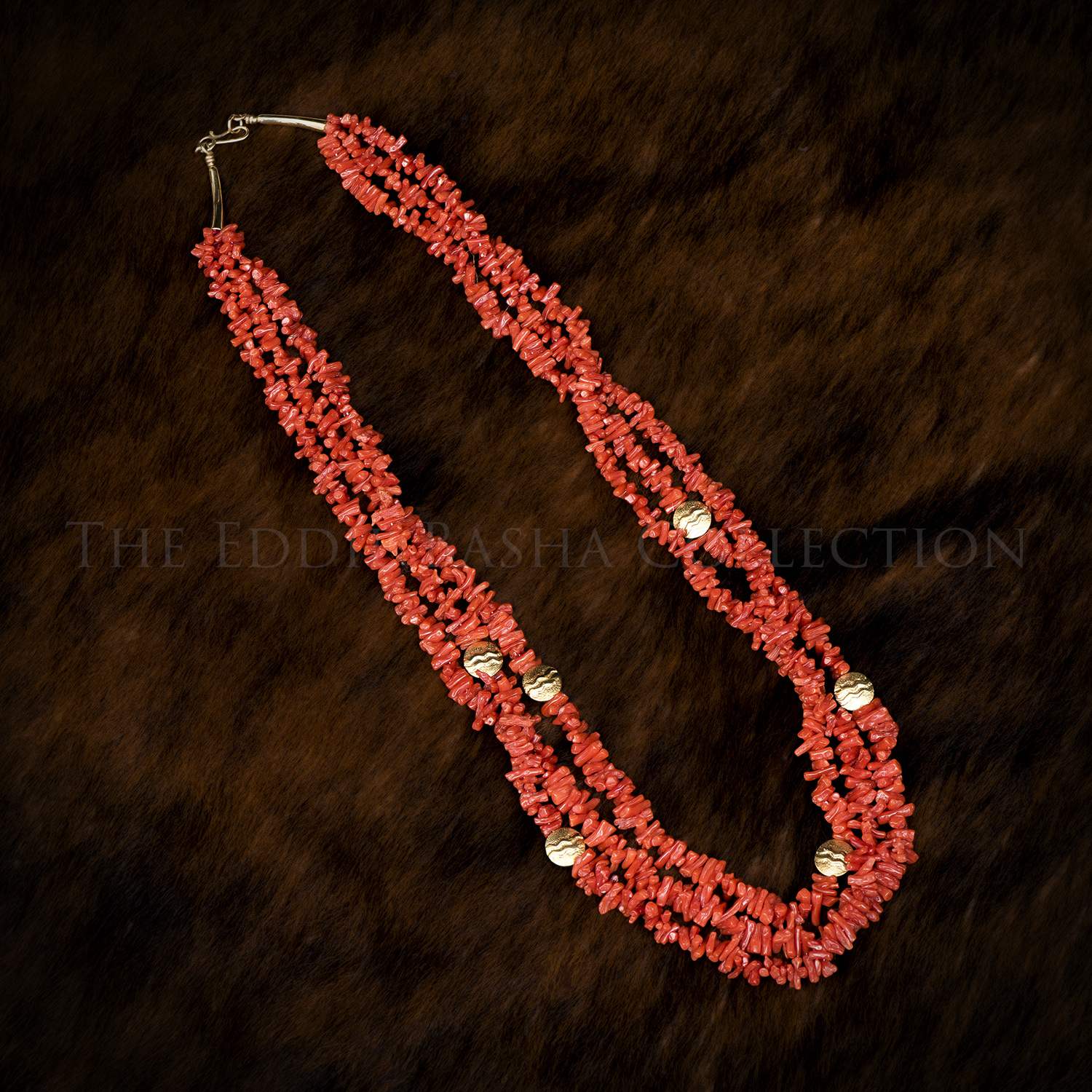
Three-Strand Necklace | Unknown Artist
Artist: Jewelry
Description: Branch Coral & Gold Discs | Dimensions: 24” Lengthjewelry
Sorry to say we were unable to determine the artisan who crafted this beautiful three-stand branch coral and gold disc necklace since there isn’t a hallmark anywhere on the piece. However, that doesn’t mean we can’t admire it for its quality of craftsmanship as well as its striking beauty.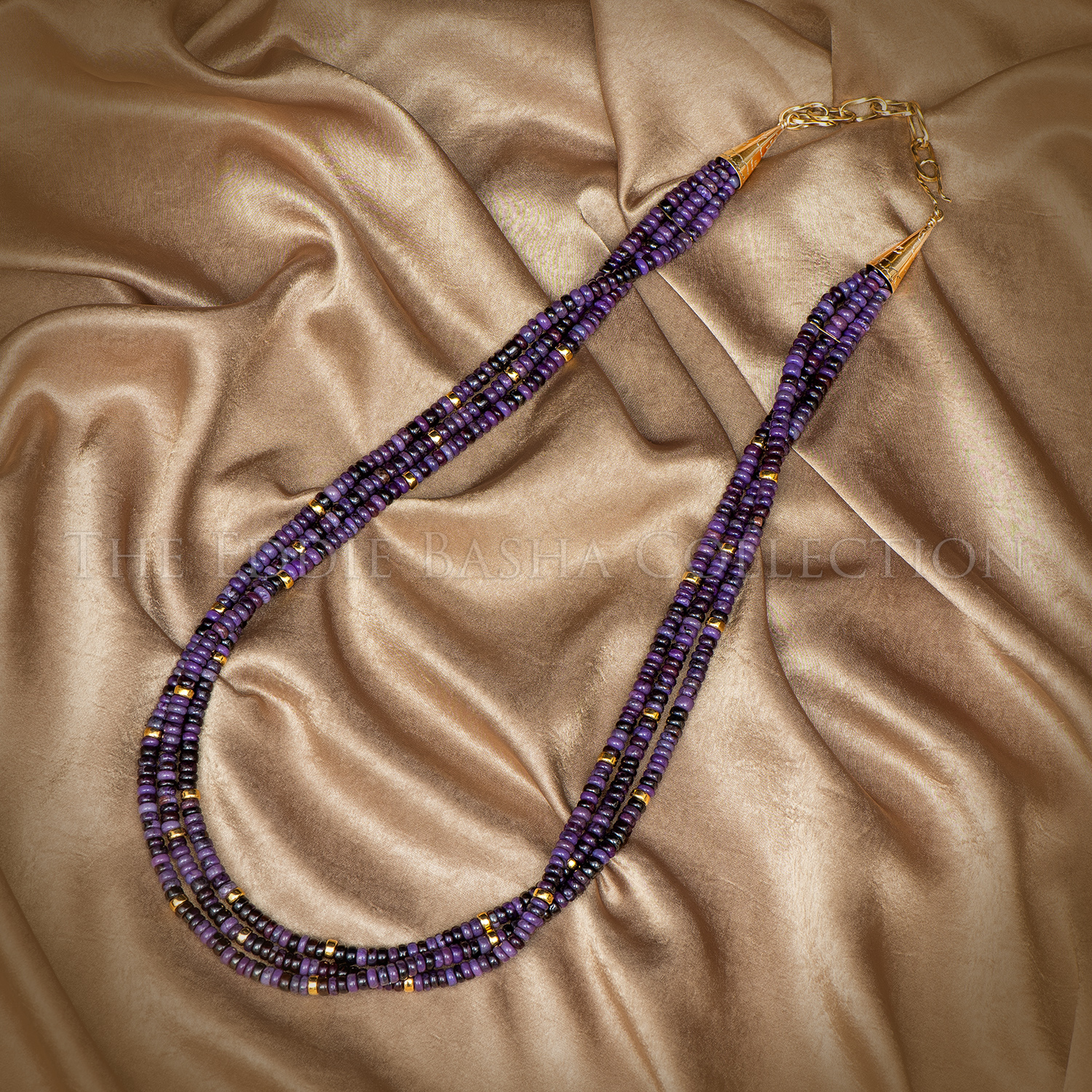
3-Strand Necklace | Terry C. (b.1935) & Joe B. Reano (b.1940)
Artist: Jewelry
Description: Purple Charoite | Dimensions: 28” Lengthjewelry
The husband-and-wife team of Terry C. and Joe B. Reano are among the few Pueblo artists who still make beads completely by hand without the use of power tools. Both learned these techniques from their parents and have passed the tradition on to their children.
To make their handmade beads, they start by rubbing a piece of stone or shell against a large, course slab of sandstone to flatten it. Then, using a hand-powered pump drill, they drill a hole. Thicker pieces require drilling from both sides. To make the beads round, the beads are strung on a wire and then rolled against sandstone or pulled through a groove of a rough stone. The circular beads are smoothed with finer and finer sandstone, and then finally polished with buckskin.
It can take two or three months to finish one strand, and in the process, roughly half of the original bead material is ground away into dust.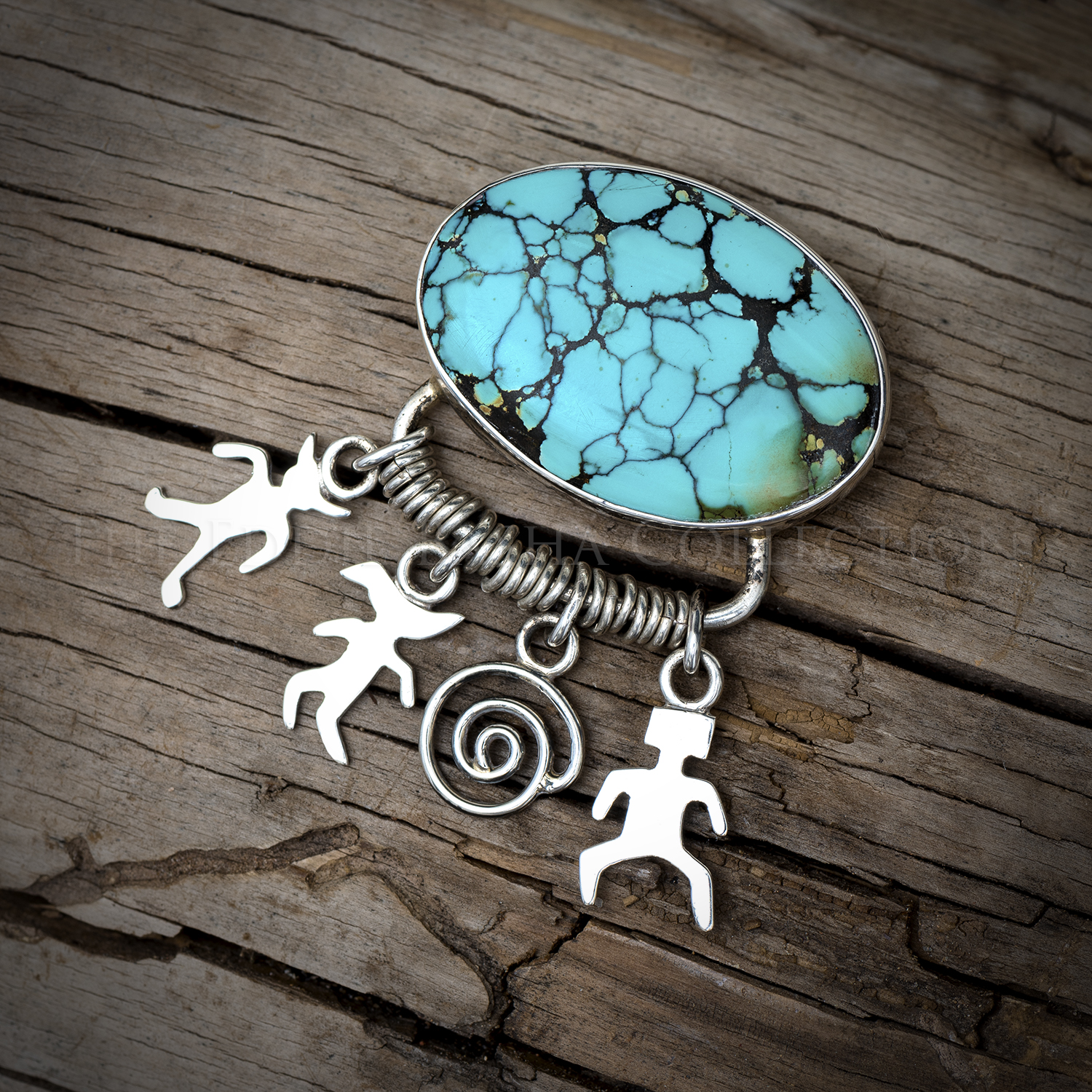
Brooch
Artist: Jewelry
Description: Kay Begay Rogers | Turquoise & Silver | Dimensions: 2 ½”h x 1 ¼”wjewelry
The talented and creative Navajo silversmith, Kay Begay Rogers, fabricated this unique brooch which features three petroglyph figures and the swirl symbol which symbolizes the migration patterns of tribes and is a metaphor for life’s journey.
Kay’s work is typically modern in design and exceptionally crafted with an emphasis on detail and often includes cultural references. Her father, the renowned silversmith, Kenneth Begay, influenced her work and that of her siblings Sylvia and Harvey.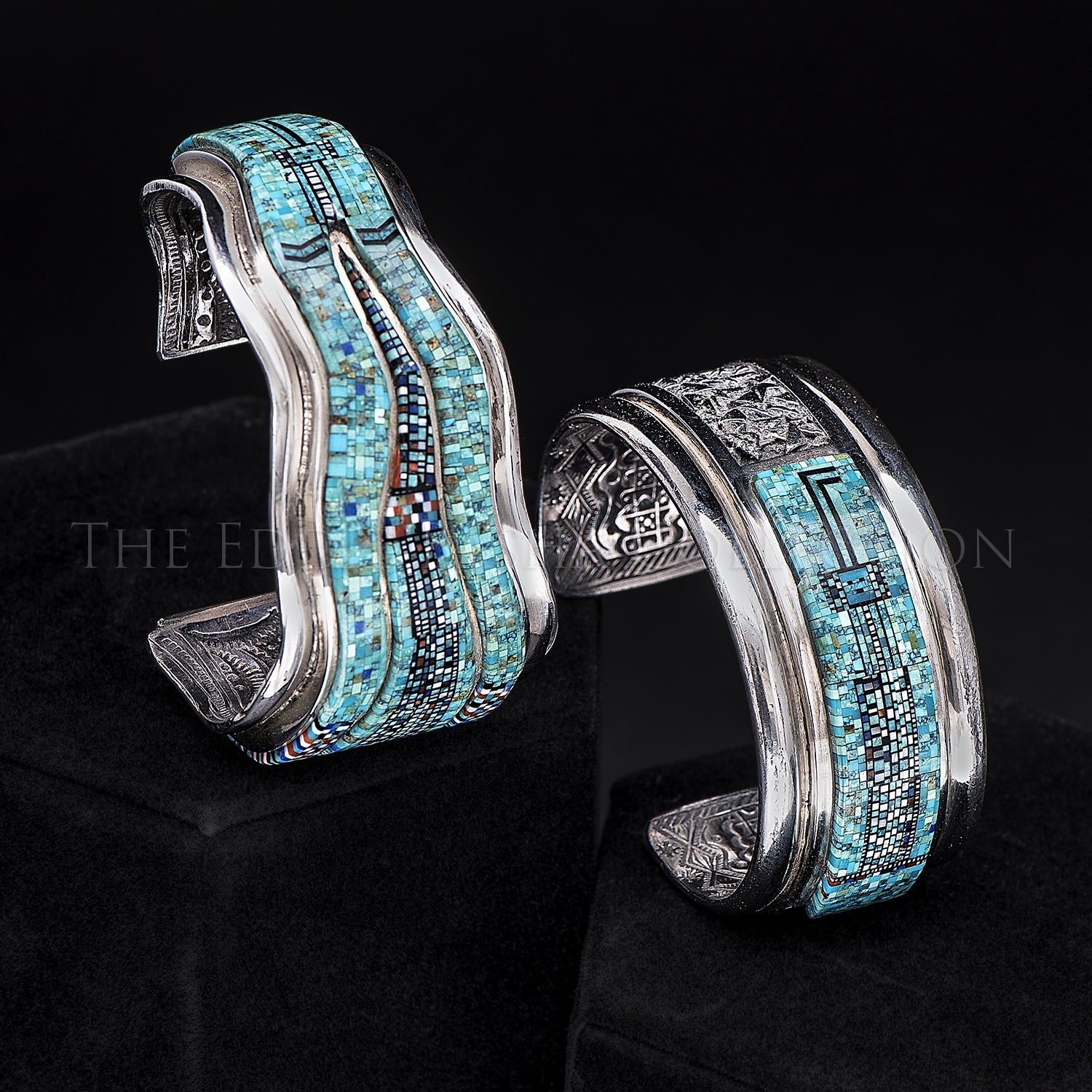
Inlay Bracelets
Artist: Jewelry
Description: Carl (b.1952) & Irene Clark (b.1950) | Silver, turquoise, lapis, coral and othersjewelry
Carl and Irene Clark, self-taught and known for their extremely detail-oriented effort that goes into their micro fine intarsia inlay jewelry, have worked together as a husband and wife duo since 1974. Both are from large Navajo families with artisanal roots as rug weavers. Carl has shared “I learned all my smithing and inlaying techniques by trial and error without a teacher or predecessor. Once I began to inlay, it took two years of progression to perfect my micro-fine inlaying techniques. There was no category for this type of inlay back then, so I classified it as “micro-fine intarsia.”
Working together they cut, assemble and inlay the stones while Irene hand fabricates the gold and silver. Irene does much of the design work and Carl does the tufa stone casting. They often incorporate traditional Navajo figures such as the Yei figure. The Clarks did not pattern themselves after any European or American jewelers even though they found out after five years of creating their jewelry that there were other micro-fine jewelry artist in the Art nouveau style and Art Deco Era. “We take pride in our own original creations using our traditional reflections. For example, Rainbow Man Yei represents the “jewelry of protection” theme. Artistically speaking, we use the inlay as a picture and metal work as a picture frame.”
Carl and Irene take pride in their work and it shows in the detail. They feel that it reflects the Navajo tradition. “We use good feelings and make jewelry traditionally with precision and care without rushing. Our jewelry takes much longer to make than other types of jewelry pieces.”
In addition to Carl and Irene’s work being featured in numerous books and publications, they have received numerous awards, honors and accolades.
Necklace
Artist: Jewelry
Description: Sylvia Begay Radcliffe (b.1943) | Silver & Turquoise | Dimensions: 22”jewelry
Following in the footsteps of renowned Navajo silversmith Kenneth Begay, her late father, Sylvia Begay Radcliffe has forged a solid reputation in the field as evidenced by this stunning necklace. It is comprised of fourteen fluted beads that are 14mm in size that serve as spacers along with turquoise discs between the fifteen graduated fluted beads that range in size from 25mm to 40mm at the largest.
Sylvia, along with her two siblings Kay Begay Rogers and Harvey Begay (d.2010), carry on not only the silversmith traditions they learned from their father, but each found their own unique, creative and award-winning design paths as master craftsmen in their respective practices.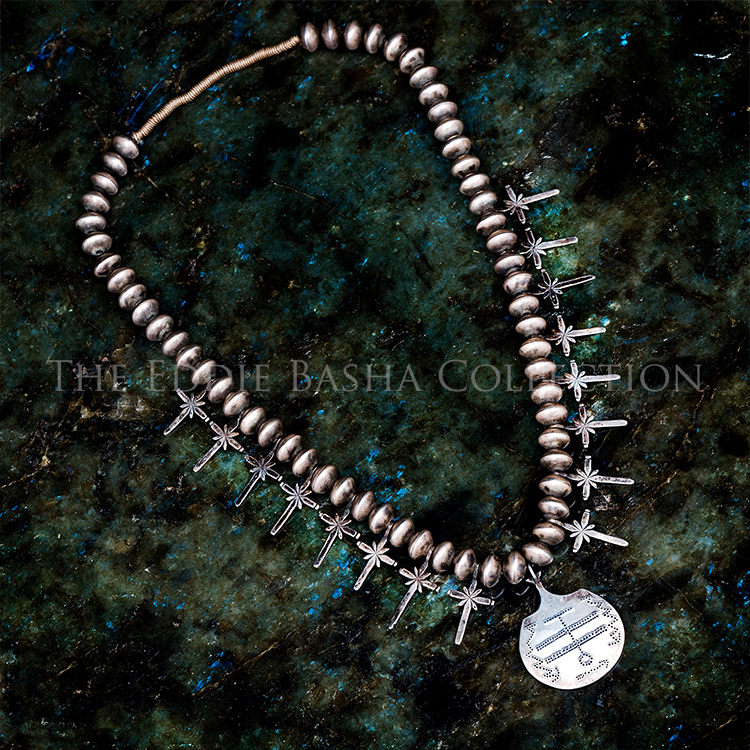
Isleta Cross Necklace
Artist: Jewelry
Description: Unknown Artist | Silver (Vintage) | Dimensions: 24”jewelry
Historic, timeless and beautiful, this vintage Isleta or Pueblo Cross necklace is a very old design associated with the Isleta Pueblo in New Mexico. It is said to have originated from the Moors and Spaniards. The Pueblo Indians adopted it as their own religious symbol because it represented the dragonfly. A cross with two bars has the appearance of a dragonfly hovering in the air with outstretched wings. When light strikes the silver, the reflective and shiny surface resembles the sheen of a dragonfly’s wings. The dragonfly was believed to be a healing and transformational creature. It was a symbol of spirituality and creativity that eliminated all negativity. It was known as the keeper of dreams, the energy within that saw all true ability and potential. With the dragonfly anything was possible. These crosses were mostly produced as gifts to brides before marriage. In times of financial distress, a woman might sell other jewelry items, but never the cross which ultimately made these pieces very rare and collectible items. Each hand-made necklace is unique which accounts for the stylized variations between crosses and beads. (Narrative Source: Silver Plume Gallery)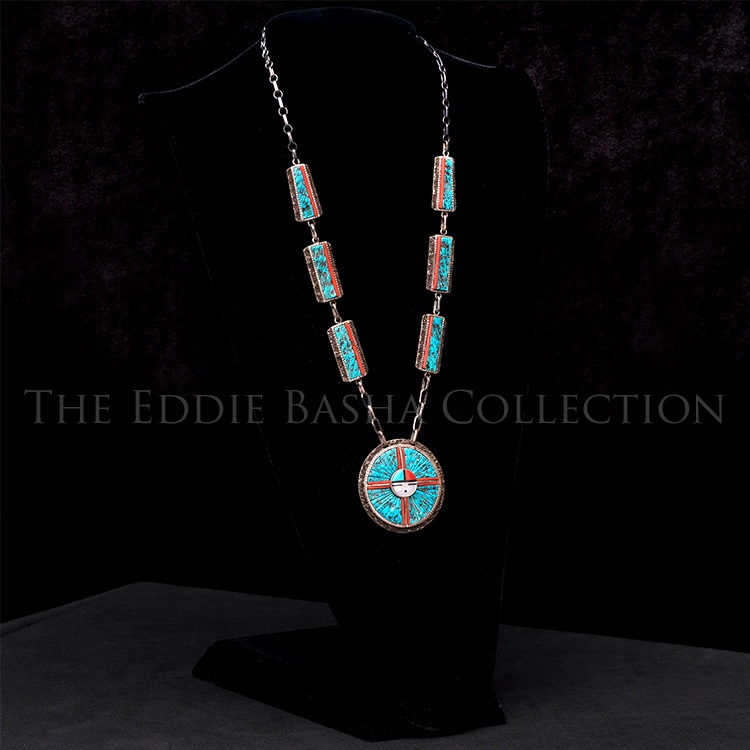
Zuni Inlay Necklace
Artist: Jewelry
Description: Roland Eustace (Zuni) | Silver, turquoise, coral, jet and mother of pearl | 22” Lengthjewelry
Owned and operated by the 19 pueblo tribes of New Mexico, Shumakolowa Native Arts shared the following on its website: “The Sunface is an ancient symbol in Zuni culture, where it represents the sacred Sun Father. The Zuni have always honored the Sun’s vital role in the cycling of seasons and the success of crops, recognizing that the Sun’s warmth sustains life, enables growth, and brings joy and prosperity to the people. The symbol’s round motif depicts the Sun with a forehead split down the middle to reflect the eternal balance between sunrise and sunset. Rectangular eyes and a round mouth complete the face, and the whole is encircled by feathers that radiate outward like sunlight.
For centuries the Sunface design has appeared on a variety of surfaces and objects, but in its most cherished traditional form it’s composed of precious stones that are as meaningful as they are beautiful. Turquoise represents oneness between the physical and spiritual realms; coral offers protection and comfort. Made of mother of pearl, the sun’s main face embodies intuition and imagination and the black jet of fossilized wood completes the face’s features. Together these four materials and their vividly contrasting colors balance each other within a unified circle."
The beautiful vintage Sunface necklace shown here was exquisitely handcrafted by Roland Eustace of the Pueblo of Zuni who began his work during the late 1950s, early 1960s.
Ring
Artist: Jewelry
Description: Eveli Sabatie (b.1940) | Silver/Turquoisejewelry
Eveli Sabatie’s circuitous route to Tucson is an interesting one. After having been born in Algeria, raised in Morocco, educated in Paris at the Sorbonne, she found herself on Haight Street in San Francisco during the early 1970s. There she met three Hopi men who invited her to a ceremonial dance on the Third Mesa in Hotevilla, Arizona. Unfortunately, Eveli confused the dates and arrived early. By happenstance while tending to her laundry, she met famed jeweler Charles Loloma.
“Charles was very, very interested in people, and even more curious when the person was a lady,” Sabatie shared. “I got intrigued when he asked me, ‘What have you done in your life so far?’” She then told him she’d been drawing and sewing tapestries when he inquired, “Would you like to learn how to make jewelry?”
And there, on the Hopi reservation, Sabatie honed her skills alongside one of the finest innovators of his time. The similarities between her North African cultural roots and that of the Hopi, the surrounding mountains and landscapes, and the ceremonial drumbeats resonated within and she found her own voice and applied it to her work. After a four year apprenticeship and determined to spread her independent wings, she set up a studio for herself in Santa Fe and began showing her work at local galleries and in numerous others across the country.
In 1979, Sabatie moved to Tucson where she has lived ever since producing hundreds of works until arthritic and vision issues forced retirement from her craft in 1998. Currently, she remains a practicing yoga student and instructor.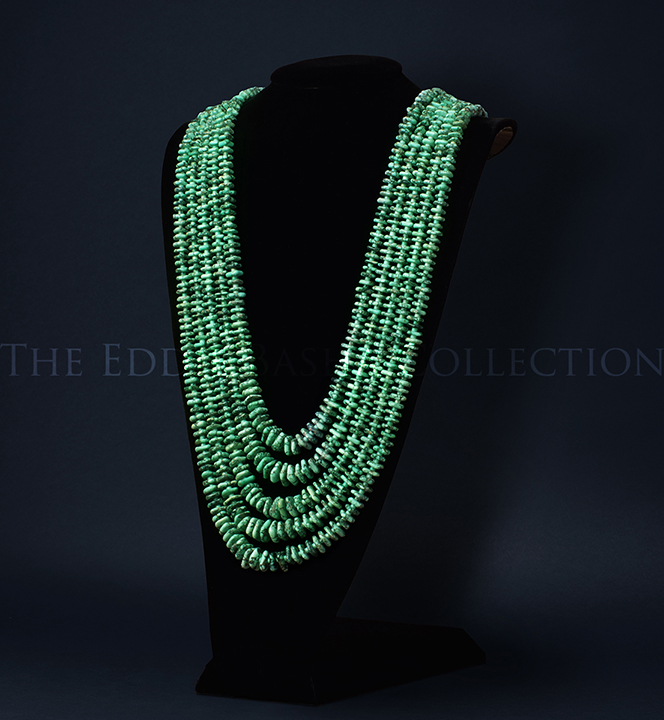
Carico Lake Turquoise (5 Strand) w/ Silver Cone Clasp
Artist: Jewelry
Description: Terry & Joe Reano | Necklace (1996) | 15 x 1.3jewelry
Terry and Joe Reano are among the premiere bead makers of Santo Domingo. Having both grown up there, Terry learned to make these beads as a child, and Joe has served on the Pueblo council. Their joint fame is certainly because every single bead of theirs is always made entirely by hand, the traditional way.
The husband-and-wife team of Joe B. and Terry Reano are among the few Pueblo artists who still make beads completely by hand, without using power tools. Both learned these techniques from their parents and have passed the tradition on to their children.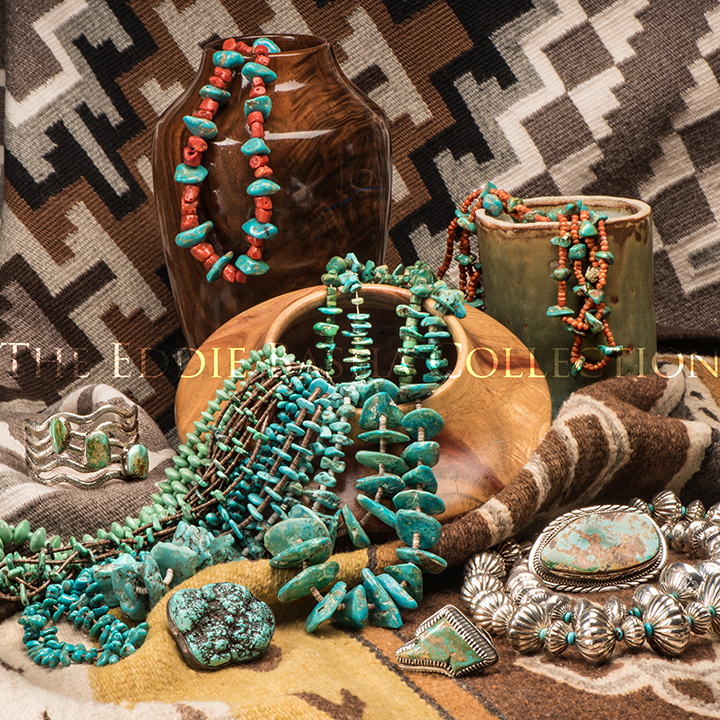
Silver & Turquoise Jewelry, Navajo Rugs, Wood Bowl
Artist: Jewelry
jewelry
Earrings
Artist: Jewelry
Description: Denise Wallace (b.1957) | Fossilized Ivory/Sterling Silver (1988) | 1 ½”h x 1”wjewelry
“Technically astounding, aesthetically beautiful and culturally important. These are just some of the ways in which Denise Wallace’s jewelry can be described. Inspired by the stories of her Chugach Aleut ancestors, her unique creations have made her one of the best-known Alaska Native jewelers of our time. (Featured on the left in this image are a pair of Denise’s scrimshawed, fossilized ivory and sterling silver earrings, circa 1988.)
Wallace began her artistic journey as a student at the Institute of American Indian Arts in Santa Fe, New Mexico in the late seventies. After graduating, she and her husband Samuel remained in Santa Fe creating and selling work from their studio and gallery for twenty years. In 1999, they moved to the tropics of Hawaii where their collaborations continued until Samuel’s passing in 2010.”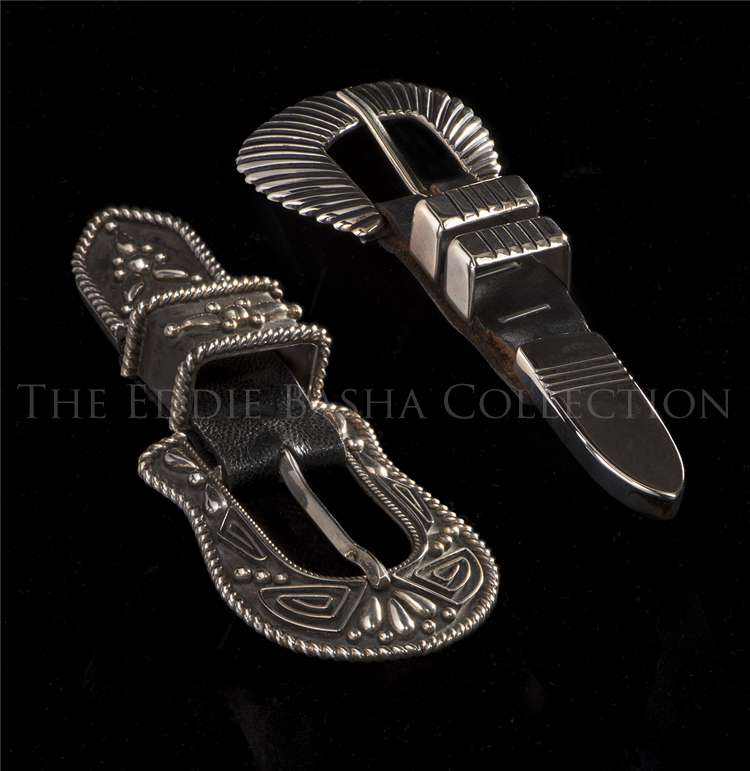
Navajo Belt Buckles
Artist: Jewelry
Description:jewelry
Billy Betoney | Silver/Leather | 2”h x 6”w (lower left)
Unidentifed Silversmith | Silver/Leather | 2”h x 5 ¼”w (upper right)
The lower left belt buckle is a Billy Betoney original masterwork. Billy learned silversmithing during the 1970s from his wife Betty. Perhaps it was the art education he received in his youth that rendered him a natural in this new medium or perhaps it was his instructor. Either way, Billy and Betty are a perfect fit as are their talents.
With experience under his belt, Billy’s designs became more visionary. By utilizing some of the design elements of his mother’s rugs, he would custom cut and form silver strips into the desired shapes he needed. After five unsuccessful vendor entry attempts to Santa Fe Indian Market, a relative shared his booth with Billy in 1989. That very same year he won the prestigious award “Most Creative Design – Any Class.” Thereafter he continued to win various awards consecutively.
Unfortunately, the buckle on the upper right, though artisan hallmark stamped, is the work of an unidentified silversmith.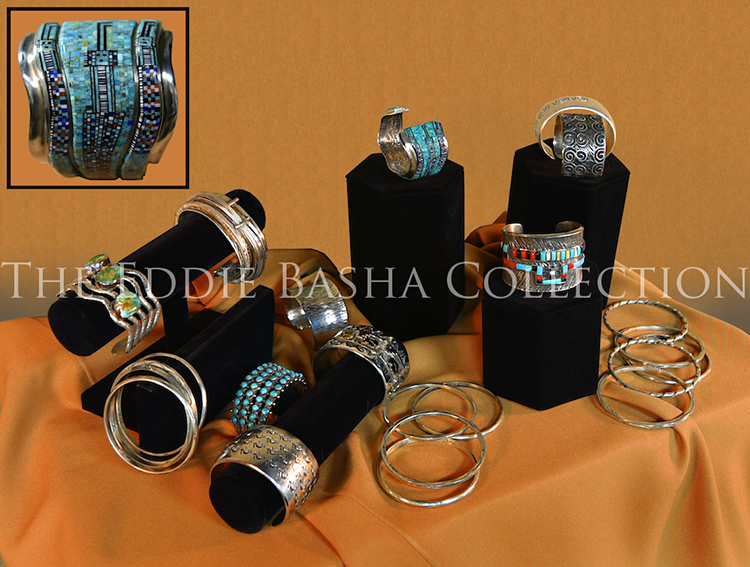
Bracelet Assortment
Artist: Jewelry
jewelry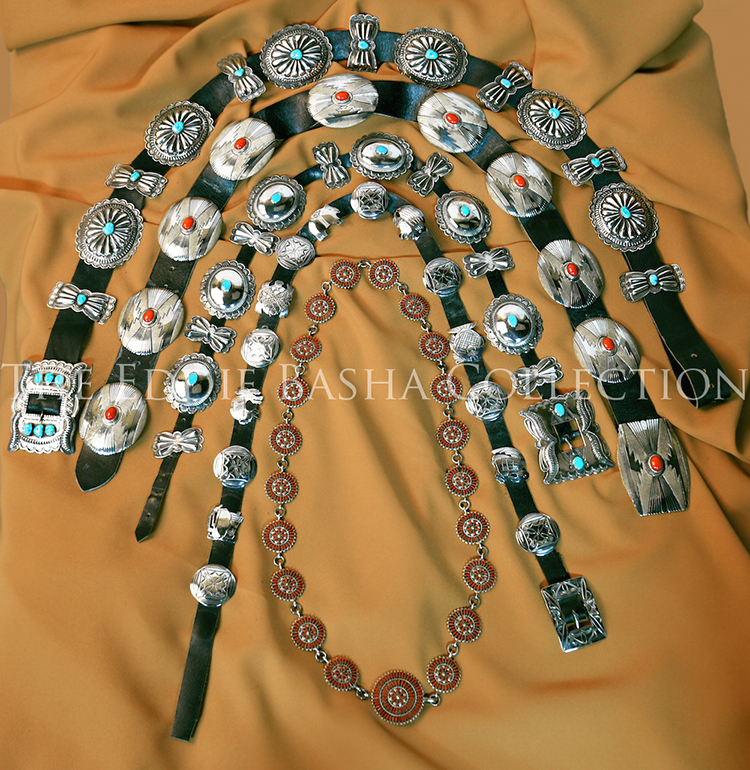
Concho Belts
Artist: Jewelry
jewelry
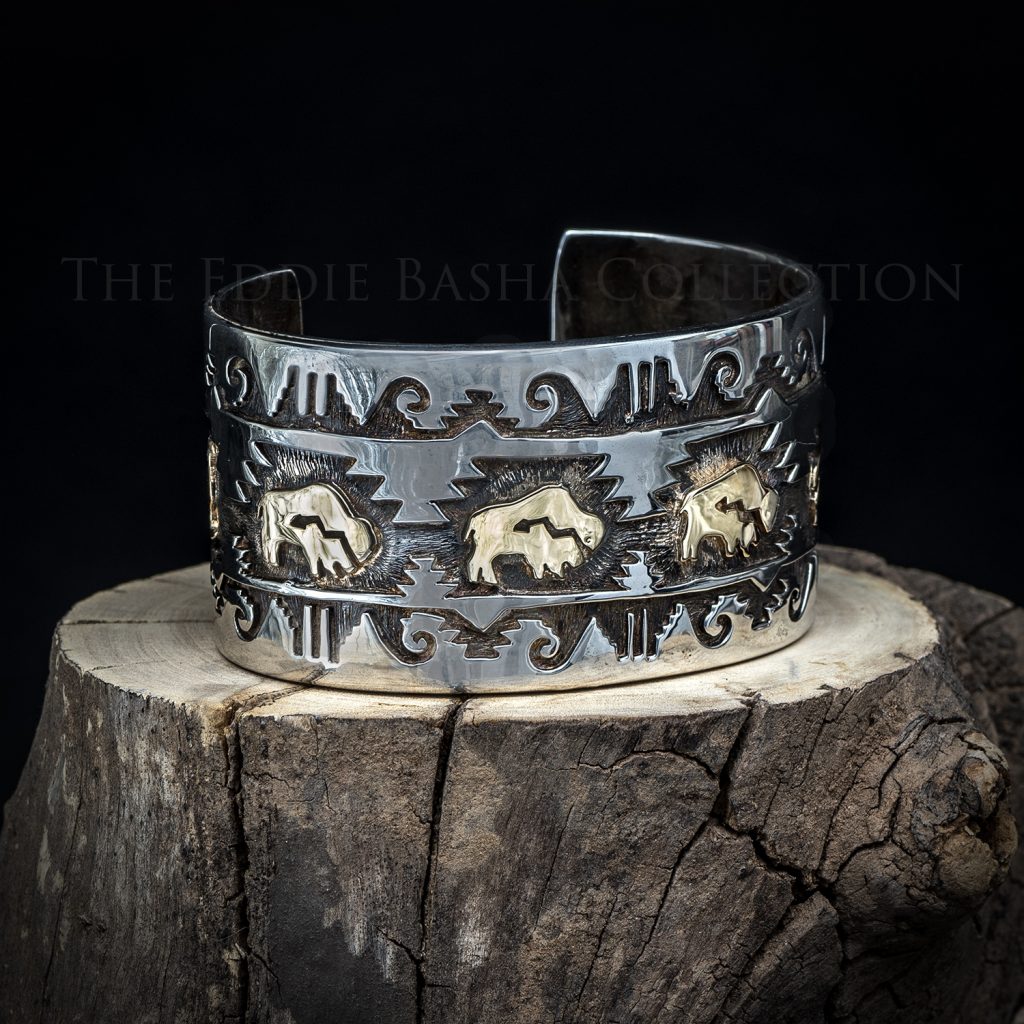 Silver & Gold Pictoral Cuff
Silver & Gold Pictoral Cuff Wichita jewelry designer Dina Huntinghorse incorporates a blend of traditional and contemporary jewelry techniques to create masterful works of wearable art. Although gold and silver work are rarely seen among the tribes of the Great Plains, Dina's life experiences introduced her to the craft, and inspired her to develop her own unique style.
Raised in southwestern Oklahoma, Dina's first love was of horses, and she learned to reproduce their likeness in pencil sketches and paintings. She was later taught the traditional art of beadwork by an aunt and became known for her beaded deerskin purses. In 1989, her interest in jewelry was piqued when her late husband, Navajo jeweler Herbert Taylor, taught her to cut beads and do inlay work. Dina began making jewelry on her own in 1996. Her work is featured in galleries throughout the southwest, and she is a regular participant at the Heard Museum and Santa Fe Indian Markets.
Along with her respect for the horse, Dina is also known for her affection for the wolf. Through many of her designs, Dina honors her tribal teachings of the wolf's legendary hunting abilities and their human-like regard for the family, or pack.
Untitled | Dina Huntinghorse (b.1962)
Artist: Jewelry
Description:
Silver & Gold Pictoral Cuff
Wichita jewelry designer Dina Huntinghorse incorporates a blend of traditional and contemporary jewelry techniques to create masterful works of wearable art. Although gold and silver work are rarely seen among the tribes of the Great Plains, Dina's life experiences introduced her to the craft, and inspired her to develop her own unique style.
Raised in southwestern Oklahoma, Dina's first love was of horses, and she learned to reproduce their likeness in pencil sketches and paintings. She was later taught the traditional art of beadwork by an aunt and became known for her beaded deerskin purses. In 1989, her interest in jewelry was piqued when her late husband, Navajo jeweler Herbert Taylor, taught her to cut beads and do inlay work. Dina began making jewelry on her own in 1996. Her work is featured in galleries throughout the southwest, and she is a regular participant at the Heard Museum and Santa Fe Indian Markets.
Along with her respect for the horse, Dina is also known for her affection for the wolf. Through many of her designs, Dina honors her tribal teachings of the wolf's legendary hunting abilities and their human-like regard for the family, or pack.
jewelryWichita jewelry designer Dina Huntinghorse incorporates a blend of traditional and contemporary jewelry techniques to create masterful works of wearable art. Although gold and silver work are rarely seen among the tribes of the Great Plains, Dina's life experiences introduced her to the craft, and inspired her to develop her own unique style.
Raised in southwestern Oklahoma, Dina's first love was of horses, and she learned to reproduce their likeness in pencil sketches and paintings. She was later taught the traditional art of beadwork by an aunt and became known for her beaded deerskin purses. In 1989, her interest in jewelry was piqued when her late husband, Navajo jeweler Herbert Taylor, taught her to cut beads and do inlay work. Dina began making jewelry on her own in 1996. Her work is featured in galleries throughout the southwest, and she is a regular participant at the Heard Museum and Santa Fe Indian Markets.
Along with her respect for the horse, Dina is also known for her affection for the wolf. Through many of her designs, Dina honors her tribal teachings of the wolf's legendary hunting abilities and their human-like regard for the family, or pack.
 Silver, Gold, Turquoise, Coral, Mother of Pearl, and Jet
Silver, Gold, Turquoise, Coral, Mother of Pearl, and Jet “The Navajo silver bracelet passed from hand to hand, wrist to wrist, generation to generation; silversmith to mother, mother to daughter, daughter to medicine man and medicine man to the needy. It passed to a trader in Gallup, ended up as dead pawn, was purchased by a Navajo man, given to a young Australian woman, flown across an ocean, stored in a jewelry box, carried up a mountain and then, as if by magic, found its way home again. Each Navajo silver bracelet has a history.” Quote Source: Perry Null Trading Company
Are you aware of the history (or story) attached to your bracelet?
Silver Bracelets | Assorted Artists/Some Unknown: Kay Begay, Norbert Peshlakai, Cheyenne Harris
Artist: Jewelry
Description:
Silver, Gold, Turquoise, Coral, Mother of Pearl, and Jet
“The Navajo silver bracelet passed from hand to hand, wrist to wrist, generation to generation; silversmith to mother, mother to daughter, daughter to medicine man and medicine man to the needy. It passed to a trader in Gallup, ended up as dead pawn, was purchased by a Navajo man, given to a young Australian woman, flown across an ocean, stored in a jewelry box, carried up a mountain and then, as if by magic, found its way home again. Each Navajo silver bracelet has a history.” Quote Source: Perry Null Trading Company
Are you aware of the history (or story) attached to your bracelet?
jewelry“The Navajo silver bracelet passed from hand to hand, wrist to wrist, generation to generation; silversmith to mother, mother to daughter, daughter to medicine man and medicine man to the needy. It passed to a trader in Gallup, ended up as dead pawn, was purchased by a Navajo man, given to a young Australian woman, flown across an ocean, stored in a jewelry box, carried up a mountain and then, as if by magic, found its way home again. Each Navajo silver bracelet has a history.” Quote Source: Perry Null Trading Company
Are you aware of the history (or story) attached to your bracelet?
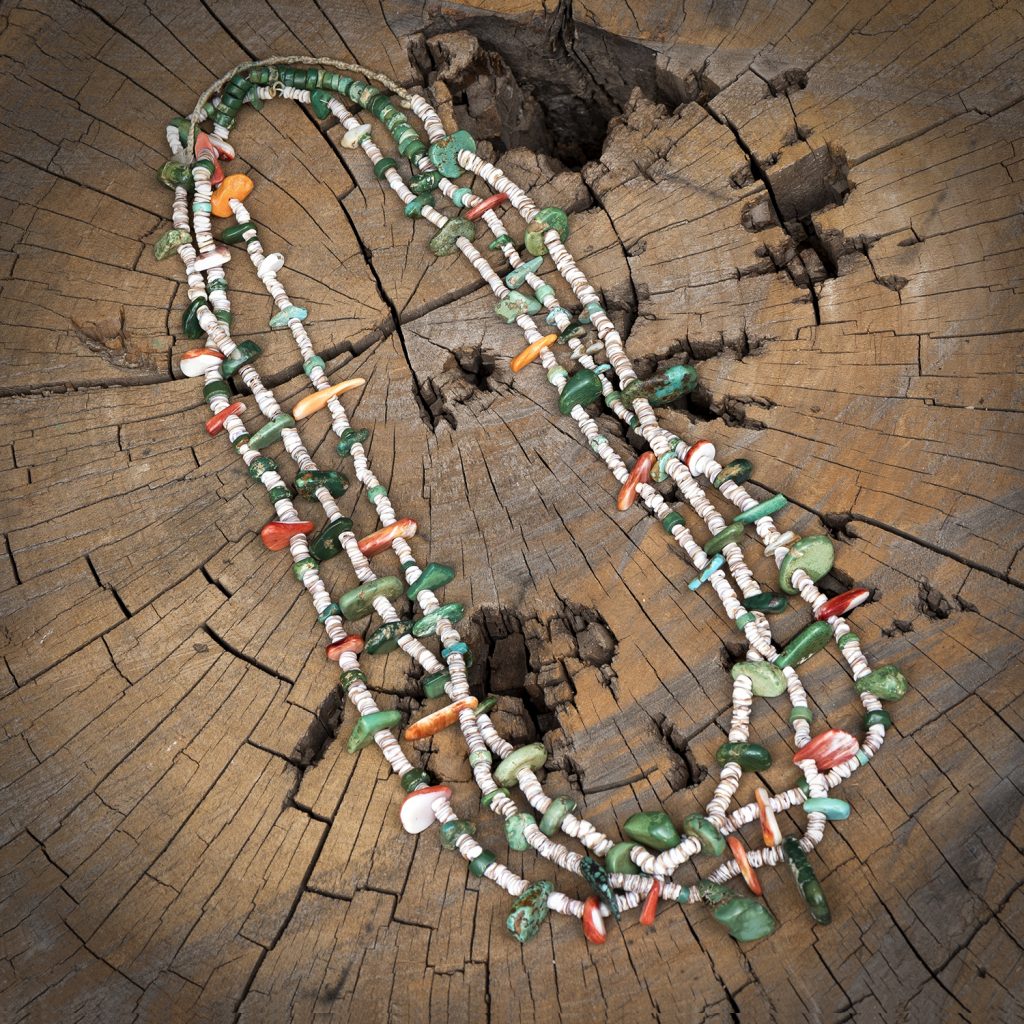 Heishe, Turquoise & Spiney Oyster
Heishe, Turquoise & Spiney OysterTo borrow the phrase, “we’ve come a long way baby” just might be an understatement. The evolution of handcrafted items has been nothing short of miraculous. Just think of how far mankind has evolved since its early use of stones as tools. Whether out of necessity, cultural practice or simply for living in beauty, throughout time there has been one constant … we look to the past to create for the present. What’s old is new again!
Vintage Heishe Necklace | Unknown Artist
Artist: Jewelry
Description:
Heishe, Turquoise & Spiney Oyster
To borrow the phrase, “we’ve come a long way baby” just might be an understatement. The evolution of handcrafted items has been nothing short of miraculous. Just think of how far mankind has evolved since its early use of stones as tools. Whether out of necessity, cultural practice or simply for living in beauty, throughout time there has been one constant … we look to the past to create for the present. What’s old is new again!
jewelryTo borrow the phrase, “we’ve come a long way baby” just might be an understatement. The evolution of handcrafted items has been nothing short of miraculous. Just think of how far mankind has evolved since its early use of stones as tools. Whether out of necessity, cultural practice or simply for living in beauty, throughout time there has been one constant … we look to the past to create for the present. What’s old is new again!
 Silver & Turquoise | Dimensions: 33”
Silver & Turquoise | Dimensions: 33”In the March 2021 edition of the Santa Fean Magazine, Rosemary Diaz wrote the following about the origins of the Squash Blossom necklace. “The distinguishing feature of the squash blossom necklace is the crescent-shaped pendant lying at its center, known as the naja. While this crescent-shaped symbol is believed to have originated in the ancient Middle East as a talisman worn to ward off evil, it would be the Spanish who brought it to what is now the American Southwest. In the late 1500s and early 1600s, these pendants were worn as iron ornaments on Spanish conquistadores’ leather horse bridles. Traded or acquired from captured horses, these ornaments soon adorned the necks of the local Native populace. When silver beading came into vogue in the late 1800s, Navajos (Diné) began displaying naja pendants on necklaces strung with small, silver beads.
Squash blossom imagery can be found in petroglyphs that pre-date European arrival in the Southwest, but this imagery did not appear in necklace form until after the Native people of the area came into contact with the Spanish. The squash blossom as a design concept originated with the Navajo. They were the first Southwest tribe to utilize the design of the edible gourd, an important source of sustenance. By the early 1900s, the symbol had traveled to the Zuni pueblo and others along the Rio Grande.
The name of the necklace comes from the tri-petal bead, the “blossom,” developed by Navajo silversmiths, who called it “yo ne maze disya gi,” or “bead that spreads out.” But the classic squash blossom necklace is actually comprised of three distinct components: the plain, unembellished round beads, round beads embellished with blooming petals and the naja centerpiece. The squash blossom as a design concept originated with the Navajo. They were the first Southwest tribe to utilize the design of the edible gourd, an important source of sustenance.
The naja is also representative of the womb; a single nugget of turquoise suspended from the pendant symbolizes a child growing within. And though the squash blossom necklace to which it is attached has no specific ceremonial function among Southwest tribes, it was traditionally worn as a symbol of one’s status, wealth and cultural belonging.
Some believe the squash blossom was taken from the pomegranate-shaped decorations found on the buttons of Spanish soldiers. Others assert that the squash blossom is just that — an homage to one of the most important foods of the early Southwest Native diet. Along with beans and corn, squash is one of the Three Sisters. This trio of crops share a symbiotic relationship when planted together and have provided sustenance to Indigenous peoples of the high desert for centuries. Origins aside, one thing is clear: the squash blossom represents a centuries-old fusion of cultures and design.
Early “First Phase” Native silversmithing, an era from 1860-1900, produced rustic, handmade squash blossom necklaces. The najas were pure silver, often cast in a type of limestone known as tufa. Later, necklaces were set with turquoise petit point and needlepoint inlay, techniques most commonly attributed to the Zuni. Many exquisite, highly collectable pieces can be found among old pawn jewelry offered by shops and galleries, as well as at estate sales. In recent years, many older pieces have been recycled into new works, a reflection of soaring prices for silver and high-quality turquoise.”
Squash Blossom | Unknown Artist
Artist: Jewelry
Description:
Silver & Turquoise | Dimensions: 33”
In the March 2021 edition of the Santa Fean Magazine, Rosemary Diaz wrote the following about the origins of the Squash Blossom necklace. “The distinguishing feature of the squash blossom necklace is the crescent-shaped pendant lying at its center, known as the naja. While this crescent-shaped symbol is believed to have originated in the ancient Middle East as a talisman worn to ward off evil, it would be the Spanish who brought it to what is now the American Southwest. In the late 1500s and early 1600s, these pendants were worn as iron ornaments on Spanish conquistadores’ leather horse bridles. Traded or acquired from captured horses, these ornaments soon adorned the necks of the local Native populace. When silver beading came into vogue in the late 1800s, Navajos (Diné) began displaying naja pendants on necklaces strung with small, silver beads.
Squash blossom imagery can be found in petroglyphs that pre-date European arrival in the Southwest, but this imagery did not appear in necklace form until after the Native people of the area came into contact with the Spanish. The squash blossom as a design concept originated with the Navajo. They were the first Southwest tribe to utilize the design of the edible gourd, an important source of sustenance. By the early 1900s, the symbol had traveled to the Zuni pueblo and others along the Rio Grande.
The name of the necklace comes from the tri-petal bead, the “blossom,” developed by Navajo silversmiths, who called it “yo ne maze disya gi,” or “bead that spreads out.” But the classic squash blossom necklace is actually comprised of three distinct components: the plain, unembellished round beads, round beads embellished with blooming petals and the naja centerpiece. The squash blossom as a design concept originated with the Navajo. They were the first Southwest tribe to utilize the design of the edible gourd, an important source of sustenance.
The naja is also representative of the womb; a single nugget of turquoise suspended from the pendant symbolizes a child growing within. And though the squash blossom necklace to which it is attached has no specific ceremonial function among Southwest tribes, it was traditionally worn as a symbol of one’s status, wealth and cultural belonging.
Some believe the squash blossom was taken from the pomegranate-shaped decorations found on the buttons of Spanish soldiers. Others assert that the squash blossom is just that — an homage to one of the most important foods of the early Southwest Native diet. Along with beans and corn, squash is one of the Three Sisters. This trio of crops share a symbiotic relationship when planted together and have provided sustenance to Indigenous peoples of the high desert for centuries. Origins aside, one thing is clear: the squash blossom represents a centuries-old fusion of cultures and design.
Early “First Phase” Native silversmithing, an era from 1860-1900, produced rustic, handmade squash blossom necklaces. The najas were pure silver, often cast in a type of limestone known as tufa. Later, necklaces were set with turquoise petit point and needlepoint inlay, techniques most commonly attributed to the Zuni. Many exquisite, highly collectable pieces can be found among old pawn jewelry offered by shops and galleries, as well as at estate sales. In recent years, many older pieces have been recycled into new works, a reflection of soaring prices for silver and high-quality turquoise.”
jewelryIn the March 2021 edition of the Santa Fean Magazine, Rosemary Diaz wrote the following about the origins of the Squash Blossom necklace. “The distinguishing feature of the squash blossom necklace is the crescent-shaped pendant lying at its center, known as the naja. While this crescent-shaped symbol is believed to have originated in the ancient Middle East as a talisman worn to ward off evil, it would be the Spanish who brought it to what is now the American Southwest. In the late 1500s and early 1600s, these pendants were worn as iron ornaments on Spanish conquistadores’ leather horse bridles. Traded or acquired from captured horses, these ornaments soon adorned the necks of the local Native populace. When silver beading came into vogue in the late 1800s, Navajos (Diné) began displaying naja pendants on necklaces strung with small, silver beads.
Squash blossom imagery can be found in petroglyphs that pre-date European arrival in the Southwest, but this imagery did not appear in necklace form until after the Native people of the area came into contact with the Spanish. The squash blossom as a design concept originated with the Navajo. They were the first Southwest tribe to utilize the design of the edible gourd, an important source of sustenance. By the early 1900s, the symbol had traveled to the Zuni pueblo and others along the Rio Grande.
The name of the necklace comes from the tri-petal bead, the “blossom,” developed by Navajo silversmiths, who called it “yo ne maze disya gi,” or “bead that spreads out.” But the classic squash blossom necklace is actually comprised of three distinct components: the plain, unembellished round beads, round beads embellished with blooming petals and the naja centerpiece. The squash blossom as a design concept originated with the Navajo. They were the first Southwest tribe to utilize the design of the edible gourd, an important source of sustenance.
The naja is also representative of the womb; a single nugget of turquoise suspended from the pendant symbolizes a child growing within. And though the squash blossom necklace to which it is attached has no specific ceremonial function among Southwest tribes, it was traditionally worn as a symbol of one’s status, wealth and cultural belonging.
Some believe the squash blossom was taken from the pomegranate-shaped decorations found on the buttons of Spanish soldiers. Others assert that the squash blossom is just that — an homage to one of the most important foods of the early Southwest Native diet. Along with beans and corn, squash is one of the Three Sisters. This trio of crops share a symbiotic relationship when planted together and have provided sustenance to Indigenous peoples of the high desert for centuries. Origins aside, one thing is clear: the squash blossom represents a centuries-old fusion of cultures and design.
Early “First Phase” Native silversmithing, an era from 1860-1900, produced rustic, handmade squash blossom necklaces. The najas were pure silver, often cast in a type of limestone known as tufa. Later, necklaces were set with turquoise petit point and needlepoint inlay, techniques most commonly attributed to the Zuni. Many exquisite, highly collectable pieces can be found among old pawn jewelry offered by shops and galleries, as well as at estate sales. In recent years, many older pieces have been recycled into new works, a reflection of soaring prices for silver and high-quality turquoise.”
 Branch Coral & Gold Discs | Dimensions: 24” Length
Branch Coral & Gold Discs | Dimensions: 24” LengthSorry to say we were unable to determine the artisan who crafted this beautiful three-stand branch coral and gold disc necklace since there isn’t a hallmark anywhere on the piece. However, that doesn’t mean we can’t admire it for its quality of craftsmanship as well as its striking beauty.
Three-Strand Necklace | Unknown Artist
Artist: Jewelry
Description:
Branch Coral & Gold Discs | Dimensions: 24” Length
Sorry to say we were unable to determine the artisan who crafted this beautiful three-stand branch coral and gold disc necklace since there isn’t a hallmark anywhere on the piece. However, that doesn’t mean we can’t admire it for its quality of craftsmanship as well as its striking beauty.
jewelrySorry to say we were unable to determine the artisan who crafted this beautiful three-stand branch coral and gold disc necklace since there isn’t a hallmark anywhere on the piece. However, that doesn’t mean we can’t admire it for its quality of craftsmanship as well as its striking beauty.
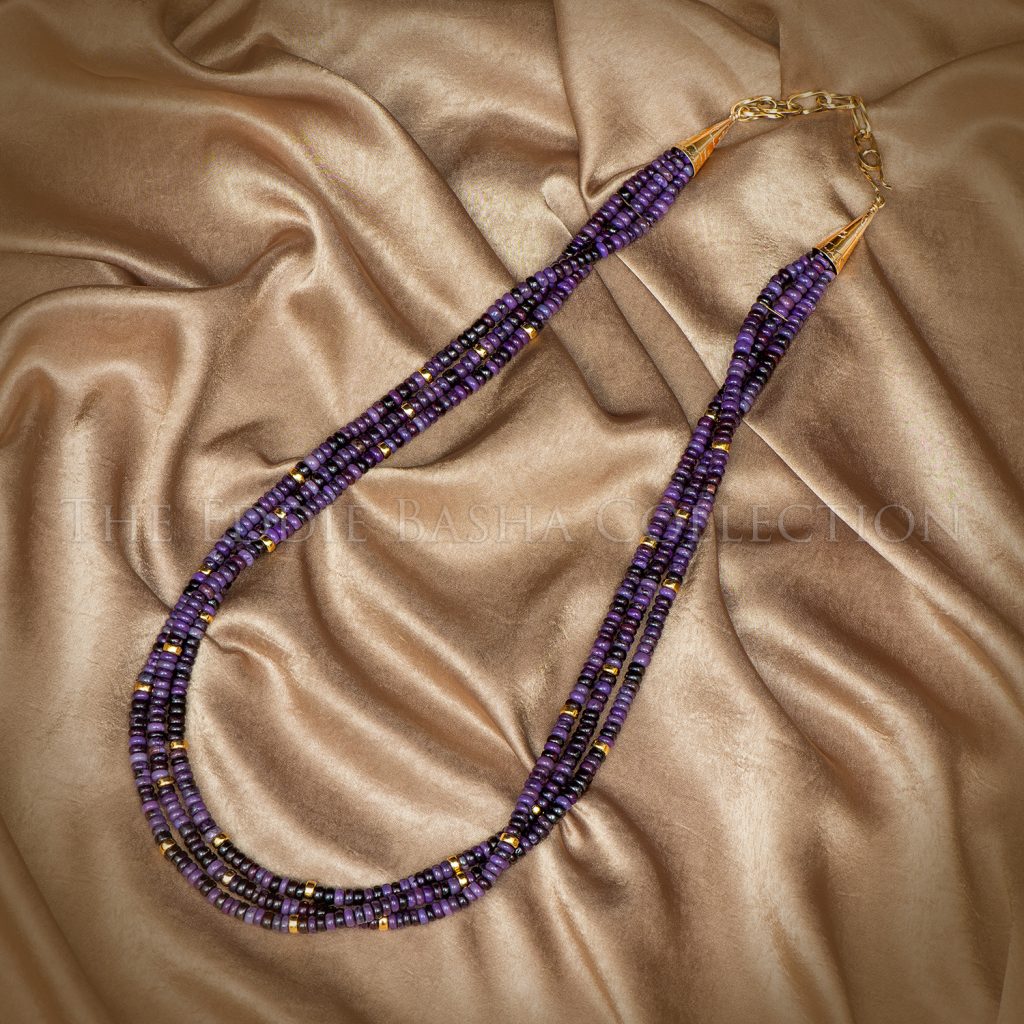 Purple Charoite | Dimensions: 28” Length
Purple Charoite | Dimensions: 28” LengthThe husband-and-wife team of Terry C. and Joe B. Reano are among the few Pueblo artists who still make beads completely by hand without the use of power tools. Both learned these techniques from their parents and have passed the tradition on to their children.
To make their handmade beads, they start by rubbing a piece of stone or shell against a large, course slab of sandstone to flatten it. Then, using a hand-powered pump drill, they drill a hole. Thicker pieces require drilling from both sides. To make the beads round, the beads are strung on a wire and then rolled against sandstone or pulled through a groove of a rough stone. The circular beads are smoothed with finer and finer sandstone, and then finally polished with buckskin.
It can take two or three months to finish one strand, and in the process, roughly half of the original bead material is ground away into dust.
3-Strand Necklace | Terry C. (b.1935) & Joe B. Reano (b.1940)
Artist: Jewelry
Description:
Purple Charoite | Dimensions: 28” Length
The husband-and-wife team of Terry C. and Joe B. Reano are among the few Pueblo artists who still make beads completely by hand without the use of power tools. Both learned these techniques from their parents and have passed the tradition on to their children.
To make their handmade beads, they start by rubbing a piece of stone or shell against a large, course slab of sandstone to flatten it. Then, using a hand-powered pump drill, they drill a hole. Thicker pieces require drilling from both sides. To make the beads round, the beads are strung on a wire and then rolled against sandstone or pulled through a groove of a rough stone. The circular beads are smoothed with finer and finer sandstone, and then finally polished with buckskin.
It can take two or three months to finish one strand, and in the process, roughly half of the original bead material is ground away into dust.
jewelryThe husband-and-wife team of Terry C. and Joe B. Reano are among the few Pueblo artists who still make beads completely by hand without the use of power tools. Both learned these techniques from their parents and have passed the tradition on to their children.
To make their handmade beads, they start by rubbing a piece of stone or shell against a large, course slab of sandstone to flatten it. Then, using a hand-powered pump drill, they drill a hole. Thicker pieces require drilling from both sides. To make the beads round, the beads are strung on a wire and then rolled against sandstone or pulled through a groove of a rough stone. The circular beads are smoothed with finer and finer sandstone, and then finally polished with buckskin.
It can take two or three months to finish one strand, and in the process, roughly half of the original bead material is ground away into dust.
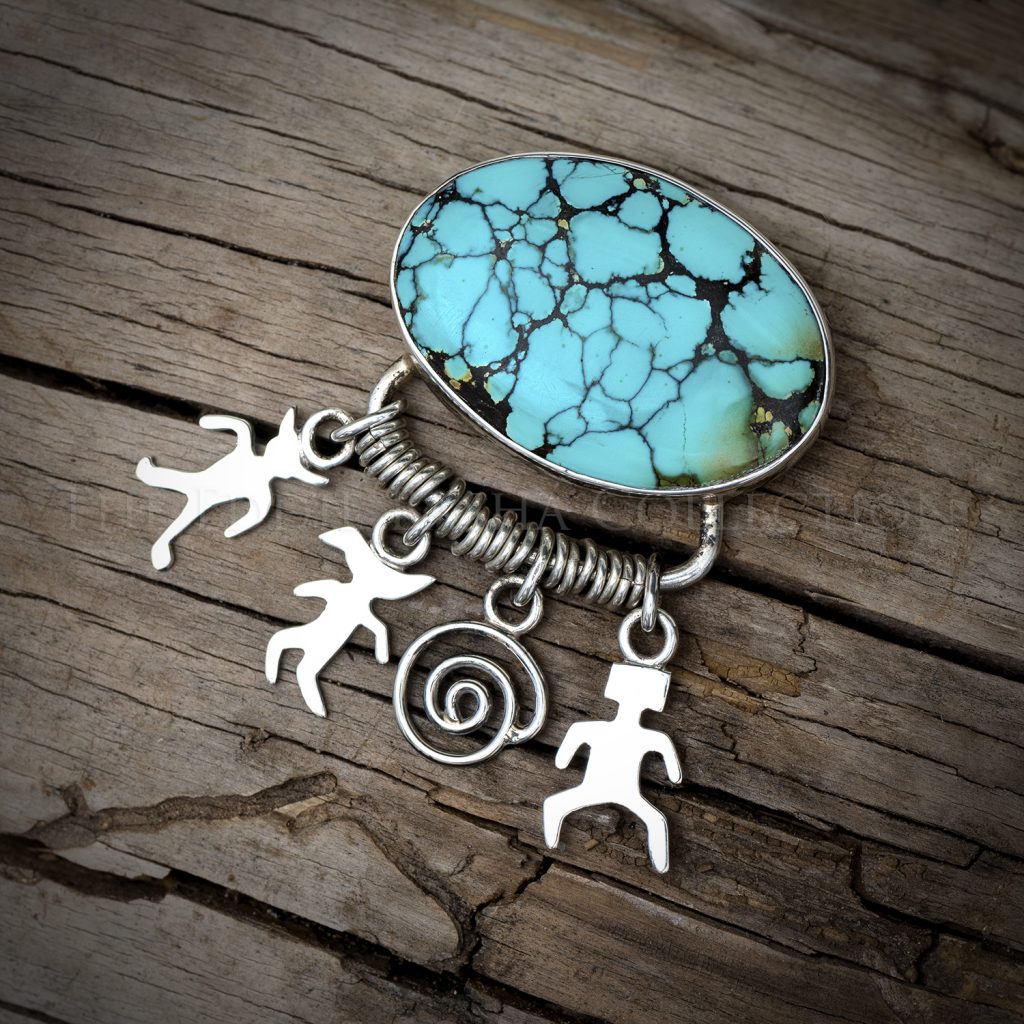 Kay Begay Rogers | Turquoise & Silver | Dimensions: 2 ½”h x 1 ¼”w
Kay Begay Rogers | Turquoise & Silver | Dimensions: 2 ½”h x 1 ¼”wThe talented and creative Navajo silversmith, Kay Begay Rogers, fabricated this unique brooch which features three petroglyph figures and the swirl symbol which symbolizes the migration patterns of tribes and is a metaphor for life’s journey.
Kay’s work is typically modern in design and exceptionally crafted with an emphasis on detail and often includes cultural references. Her father, the renowned silversmith, Kenneth Begay, influenced her work and that of her siblings Sylvia and Harvey.
Brooch
Artist: Jewelry
Description:
Kay Begay Rogers | Turquoise & Silver | Dimensions: 2 ½”h x 1 ¼”w
The talented and creative Navajo silversmith, Kay Begay Rogers, fabricated this unique brooch which features three petroglyph figures and the swirl symbol which symbolizes the migration patterns of tribes and is a metaphor for life’s journey.
Kay’s work is typically modern in design and exceptionally crafted with an emphasis on detail and often includes cultural references. Her father, the renowned silversmith, Kenneth Begay, influenced her work and that of her siblings Sylvia and Harvey.
jewelryThe talented and creative Navajo silversmith, Kay Begay Rogers, fabricated this unique brooch which features three petroglyph figures and the swirl symbol which symbolizes the migration patterns of tribes and is a metaphor for life’s journey.
Kay’s work is typically modern in design and exceptionally crafted with an emphasis on detail and often includes cultural references. Her father, the renowned silversmith, Kenneth Begay, influenced her work and that of her siblings Sylvia and Harvey.
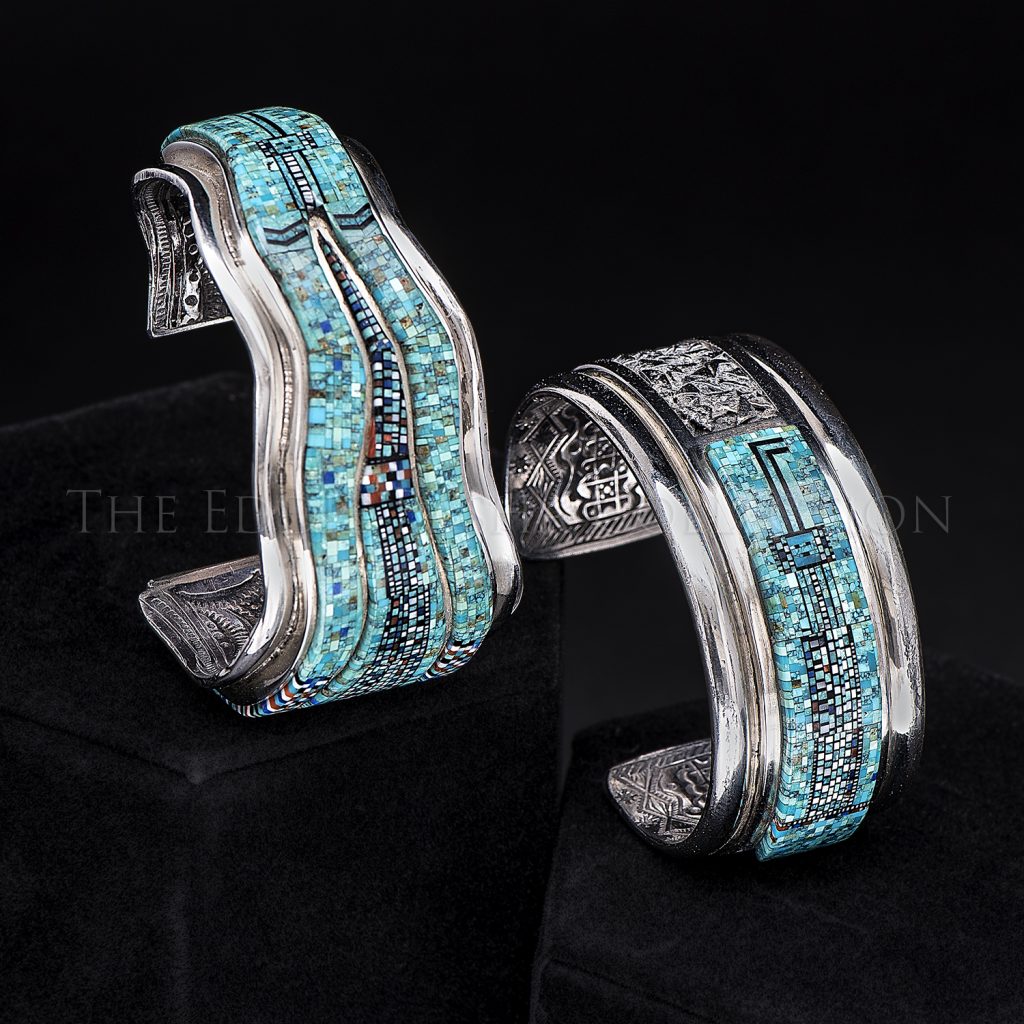 Carl (b.1952) & Irene Clark (b.1950) | Silver, turquoise, lapis, coral and others
Carl (b.1952) & Irene Clark (b.1950) | Silver, turquoise, lapis, coral and othersCarl and Irene Clark, self-taught and known for their extremely detail-oriented effort that goes into their micro fine intarsia inlay jewelry, have worked together as a husband and wife duo since 1974. Both are from large Navajo families with artisanal roots as rug weavers. Carl has shared “I learned all my smithing and inlaying techniques by trial and error without a teacher or predecessor. Once I began to inlay, it took two years of progression to perfect my micro-fine inlaying techniques. There was no category for this type of inlay back then, so I classified it as “micro-fine intarsia.”
Working together they cut, assemble and inlay the stones while Irene hand fabricates the gold and silver. Irene does much of the design work and Carl does the tufa stone casting. They often incorporate traditional Navajo figures such as the Yei figure. The Clarks did not pattern themselves after any European or American jewelers even though they found out after five years of creating their jewelry that there were other micro-fine jewelry artist in the Art nouveau style and Art Deco Era. “We take pride in our own original creations using our traditional reflections. For example, Rainbow Man Yei represents the “jewelry of protection” theme. Artistically speaking, we use the inlay as a picture and metal work as a picture frame.”
Carl and Irene take pride in their work and it shows in the detail. They feel that it reflects the Navajo tradition. “We use good feelings and make jewelry traditionally with precision and care without rushing. Our jewelry takes much longer to make than other types of jewelry pieces.”
In addition to Carl and Irene’s work being featured in numerous books and publications, they have received numerous awards, honors and accolades.
Inlay Bracelets
Artist: Jewelry
Description:
Carl (b.1952) & Irene Clark (b.1950) | Silver, turquoise, lapis, coral and others
Carl and Irene Clark, self-taught and known for their extremely detail-oriented effort that goes into their micro fine intarsia inlay jewelry, have worked together as a husband and wife duo since 1974. Both are from large Navajo families with artisanal roots as rug weavers. Carl has shared “I learned all my smithing and inlaying techniques by trial and error without a teacher or predecessor. Once I began to inlay, it took two years of progression to perfect my micro-fine inlaying techniques. There was no category for this type of inlay back then, so I classified it as “micro-fine intarsia.”
Working together they cut, assemble and inlay the stones while Irene hand fabricates the gold and silver. Irene does much of the design work and Carl does the tufa stone casting. They often incorporate traditional Navajo figures such as the Yei figure. The Clarks did not pattern themselves after any European or American jewelers even though they found out after five years of creating their jewelry that there were other micro-fine jewelry artist in the Art nouveau style and Art Deco Era. “We take pride in our own original creations using our traditional reflections. For example, Rainbow Man Yei represents the “jewelry of protection” theme. Artistically speaking, we use the inlay as a picture and metal work as a picture frame.”
Carl and Irene take pride in their work and it shows in the detail. They feel that it reflects the Navajo tradition. “We use good feelings and make jewelry traditionally with precision and care without rushing. Our jewelry takes much longer to make than other types of jewelry pieces.”
In addition to Carl and Irene’s work being featured in numerous books and publications, they have received numerous awards, honors and accolades.
jewelryCarl and Irene Clark, self-taught and known for their extremely detail-oriented effort that goes into their micro fine intarsia inlay jewelry, have worked together as a husband and wife duo since 1974. Both are from large Navajo families with artisanal roots as rug weavers. Carl has shared “I learned all my smithing and inlaying techniques by trial and error without a teacher or predecessor. Once I began to inlay, it took two years of progression to perfect my micro-fine inlaying techniques. There was no category for this type of inlay back then, so I classified it as “micro-fine intarsia.”
Working together they cut, assemble and inlay the stones while Irene hand fabricates the gold and silver. Irene does much of the design work and Carl does the tufa stone casting. They often incorporate traditional Navajo figures such as the Yei figure. The Clarks did not pattern themselves after any European or American jewelers even though they found out after five years of creating their jewelry that there were other micro-fine jewelry artist in the Art nouveau style and Art Deco Era. “We take pride in our own original creations using our traditional reflections. For example, Rainbow Man Yei represents the “jewelry of protection” theme. Artistically speaking, we use the inlay as a picture and metal work as a picture frame.”
Carl and Irene take pride in their work and it shows in the detail. They feel that it reflects the Navajo tradition. “We use good feelings and make jewelry traditionally with precision and care without rushing. Our jewelry takes much longer to make than other types of jewelry pieces.”
In addition to Carl and Irene’s work being featured in numerous books and publications, they have received numerous awards, honors and accolades.
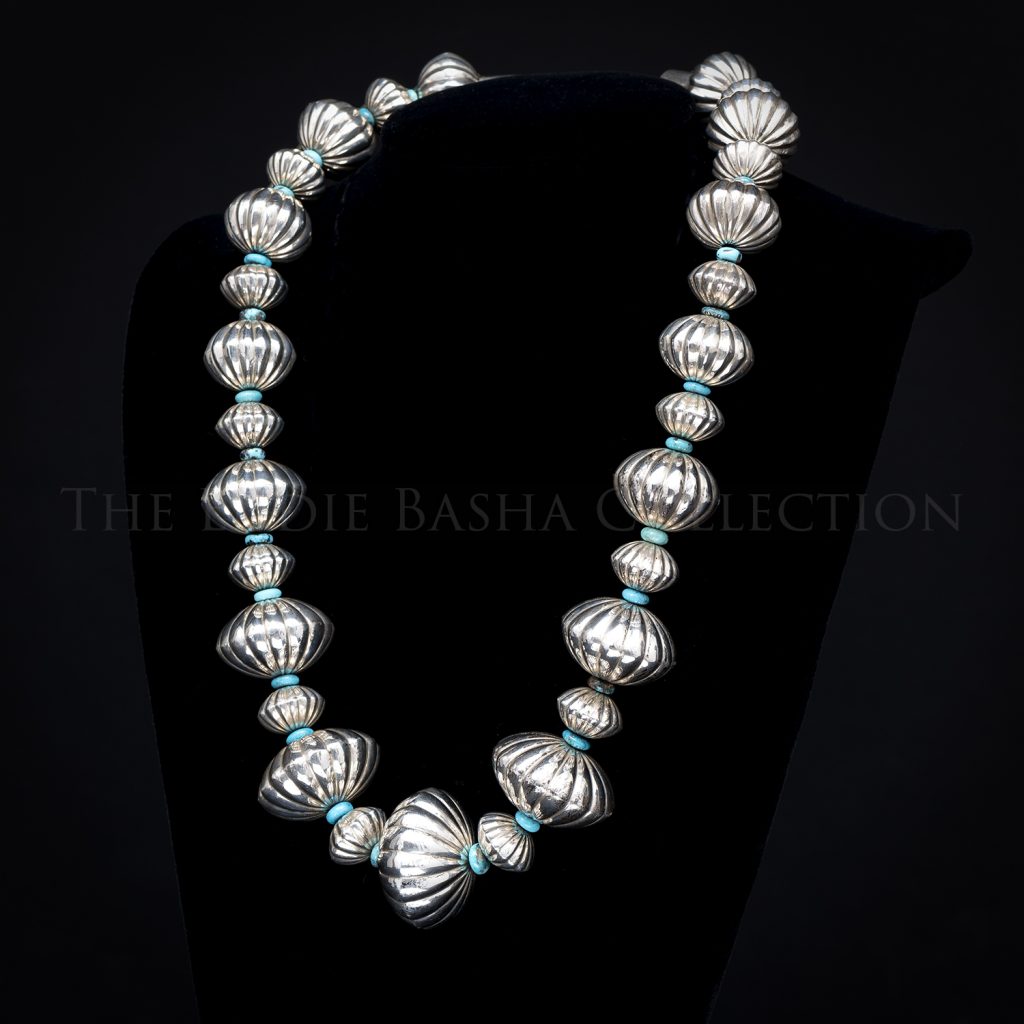 Sylvia Begay Radcliffe (b.1943) | Silver & Turquoise | Dimensions: 22”
Sylvia Begay Radcliffe (b.1943) | Silver & Turquoise | Dimensions: 22”Following in the footsteps of renowned Navajo silversmith Kenneth Begay, her late father, Sylvia Begay Radcliffe has forged a solid reputation in the field as evidenced by this stunning necklace. It is comprised of fourteen fluted beads that are 14mm in size that serve as spacers along with turquoise discs between the fifteen graduated fluted beads that range in size from 25mm to 40mm at the largest.
Sylvia, along with her two siblings Kay Begay Rogers and Harvey Begay (d.2010), carry on not only the silversmith traditions they learned from their father, but each found their own unique, creative and award-winning design paths as master craftsmen in their respective practices.
Necklace
Artist: Jewelry
Description:
Sylvia Begay Radcliffe (b.1943) | Silver & Turquoise | Dimensions: 22”
Following in the footsteps of renowned Navajo silversmith Kenneth Begay, her late father, Sylvia Begay Radcliffe has forged a solid reputation in the field as evidenced by this stunning necklace. It is comprised of fourteen fluted beads that are 14mm in size that serve as spacers along with turquoise discs between the fifteen graduated fluted beads that range in size from 25mm to 40mm at the largest.
Sylvia, along with her two siblings Kay Begay Rogers and Harvey Begay (d.2010), carry on not only the silversmith traditions they learned from their father, but each found their own unique, creative and award-winning design paths as master craftsmen in their respective practices.
jewelryFollowing in the footsteps of renowned Navajo silversmith Kenneth Begay, her late father, Sylvia Begay Radcliffe has forged a solid reputation in the field as evidenced by this stunning necklace. It is comprised of fourteen fluted beads that are 14mm in size that serve as spacers along with turquoise discs between the fifteen graduated fluted beads that range in size from 25mm to 40mm at the largest.
Sylvia, along with her two siblings Kay Begay Rogers and Harvey Begay (d.2010), carry on not only the silversmith traditions they learned from their father, but each found their own unique, creative and award-winning design paths as master craftsmen in their respective practices.
 Unknown Artist | Silver (Vintage) | Dimensions: 24”
Unknown Artist | Silver (Vintage) | Dimensions: 24”Historic, timeless and beautiful, this vintage Isleta or Pueblo Cross necklace is a very old design associated with the Isleta Pueblo in New Mexico. It is said to have originated from the Moors and Spaniards. The Pueblo Indians adopted it as their own religious symbol because it represented the dragonfly. A cross with two bars has the appearance of a dragonfly hovering in the air with outstretched wings. When light strikes the silver, the reflective and shiny surface resembles the sheen of a dragonfly’s wings. The dragonfly was believed to be a healing and transformational creature. It was a symbol of spirituality and creativity that eliminated all negativity. It was known as the keeper of dreams, the energy within that saw all true ability and potential. With the dragonfly anything was possible. These crosses were mostly produced as gifts to brides before marriage. In times of financial distress, a woman might sell other jewelry items, but never the cross which ultimately made these pieces very rare and collectible items. Each hand-made necklace is unique which accounts for the stylized variations between crosses and beads. (Narrative Source: Silver Plume Gallery)
Isleta Cross Necklace
Artist: Jewelry
Description:
Unknown Artist | Silver (Vintage) | Dimensions: 24”
Historic, timeless and beautiful, this vintage Isleta or Pueblo Cross necklace is a very old design associated with the Isleta Pueblo in New Mexico. It is said to have originated from the Moors and Spaniards. The Pueblo Indians adopted it as their own religious symbol because it represented the dragonfly. A cross with two bars has the appearance of a dragonfly hovering in the air with outstretched wings. When light strikes the silver, the reflective and shiny surface resembles the sheen of a dragonfly’s wings. The dragonfly was believed to be a healing and transformational creature. It was a symbol of spirituality and creativity that eliminated all negativity. It was known as the keeper of dreams, the energy within that saw all true ability and potential. With the dragonfly anything was possible. These crosses were mostly produced as gifts to brides before marriage. In times of financial distress, a woman might sell other jewelry items, but never the cross which ultimately made these pieces very rare and collectible items. Each hand-made necklace is unique which accounts for the stylized variations between crosses and beads. (Narrative Source: Silver Plume Gallery)
jewelryHistoric, timeless and beautiful, this vintage Isleta or Pueblo Cross necklace is a very old design associated with the Isleta Pueblo in New Mexico. It is said to have originated from the Moors and Spaniards. The Pueblo Indians adopted it as their own religious symbol because it represented the dragonfly. A cross with two bars has the appearance of a dragonfly hovering in the air with outstretched wings. When light strikes the silver, the reflective and shiny surface resembles the sheen of a dragonfly’s wings. The dragonfly was believed to be a healing and transformational creature. It was a symbol of spirituality and creativity that eliminated all negativity. It was known as the keeper of dreams, the energy within that saw all true ability and potential. With the dragonfly anything was possible. These crosses were mostly produced as gifts to brides before marriage. In times of financial distress, a woman might sell other jewelry items, but never the cross which ultimately made these pieces very rare and collectible items. Each hand-made necklace is unique which accounts for the stylized variations between crosses and beads. (Narrative Source: Silver Plume Gallery)
 Roland Eustace (Zuni) | Silver, turquoise, coral, jet and mother of pearl | 22” Length
Roland Eustace (Zuni) | Silver, turquoise, coral, jet and mother of pearl | 22” LengthOwned and operated by the 19 pueblo tribes of New Mexico, Shumakolowa Native Arts shared the following on its website: “The Sunface is an ancient symbol in Zuni culture, where it represents the sacred Sun Father. The Zuni have always honored the Sun’s vital role in the cycling of seasons and the success of crops, recognizing that the Sun’s warmth sustains life, enables growth, and brings joy and prosperity to the people. The symbol’s round motif depicts the Sun with a forehead split down the middle to reflect the eternal balance between sunrise and sunset. Rectangular eyes and a round mouth complete the face, and the whole is encircled by feathers that radiate outward like sunlight.
For centuries the Sunface design has appeared on a variety of surfaces and objects, but in its most cherished traditional form it’s composed of precious stones that are as meaningful as they are beautiful. Turquoise represents oneness between the physical and spiritual realms; coral offers protection and comfort. Made of mother of pearl, the sun’s main face embodies intuition and imagination and the black jet of fossilized wood completes the face’s features. Together these four materials and their vividly contrasting colors balance each other within a unified circle."
The beautiful vintage Sunface necklace shown here was exquisitely handcrafted by Roland Eustace of the Pueblo of Zuni who began his work during the late 1950s, early 1960s.
Zuni Inlay Necklace
Artist: Jewelry
Description:
Roland Eustace (Zuni) | Silver, turquoise, coral, jet and mother of pearl | 22” Length
Owned and operated by the 19 pueblo tribes of New Mexico, Shumakolowa Native Arts shared the following on its website: “The Sunface is an ancient symbol in Zuni culture, where it represents the sacred Sun Father. The Zuni have always honored the Sun’s vital role in the cycling of seasons and the success of crops, recognizing that the Sun’s warmth sustains life, enables growth, and brings joy and prosperity to the people. The symbol’s round motif depicts the Sun with a forehead split down the middle to reflect the eternal balance between sunrise and sunset. Rectangular eyes and a round mouth complete the face, and the whole is encircled by feathers that radiate outward like sunlight.
For centuries the Sunface design has appeared on a variety of surfaces and objects, but in its most cherished traditional form it’s composed of precious stones that are as meaningful as they are beautiful. Turquoise represents oneness between the physical and spiritual realms; coral offers protection and comfort. Made of mother of pearl, the sun’s main face embodies intuition and imagination and the black jet of fossilized wood completes the face’s features. Together these four materials and their vividly contrasting colors balance each other within a unified circle."
The beautiful vintage Sunface necklace shown here was exquisitely handcrafted by Roland Eustace of the Pueblo of Zuni who began his work during the late 1950s, early 1960s.
jewelryOwned and operated by the 19 pueblo tribes of New Mexico, Shumakolowa Native Arts shared the following on its website: “The Sunface is an ancient symbol in Zuni culture, where it represents the sacred Sun Father. The Zuni have always honored the Sun’s vital role in the cycling of seasons and the success of crops, recognizing that the Sun’s warmth sustains life, enables growth, and brings joy and prosperity to the people. The symbol’s round motif depicts the Sun with a forehead split down the middle to reflect the eternal balance between sunrise and sunset. Rectangular eyes and a round mouth complete the face, and the whole is encircled by feathers that radiate outward like sunlight.
For centuries the Sunface design has appeared on a variety of surfaces and objects, but in its most cherished traditional form it’s composed of precious stones that are as meaningful as they are beautiful. Turquoise represents oneness between the physical and spiritual realms; coral offers protection and comfort. Made of mother of pearl, the sun’s main face embodies intuition and imagination and the black jet of fossilized wood completes the face’s features. Together these four materials and their vividly contrasting colors balance each other within a unified circle."
The beautiful vintage Sunface necklace shown here was exquisitely handcrafted by Roland Eustace of the Pueblo of Zuni who began his work during the late 1950s, early 1960s.
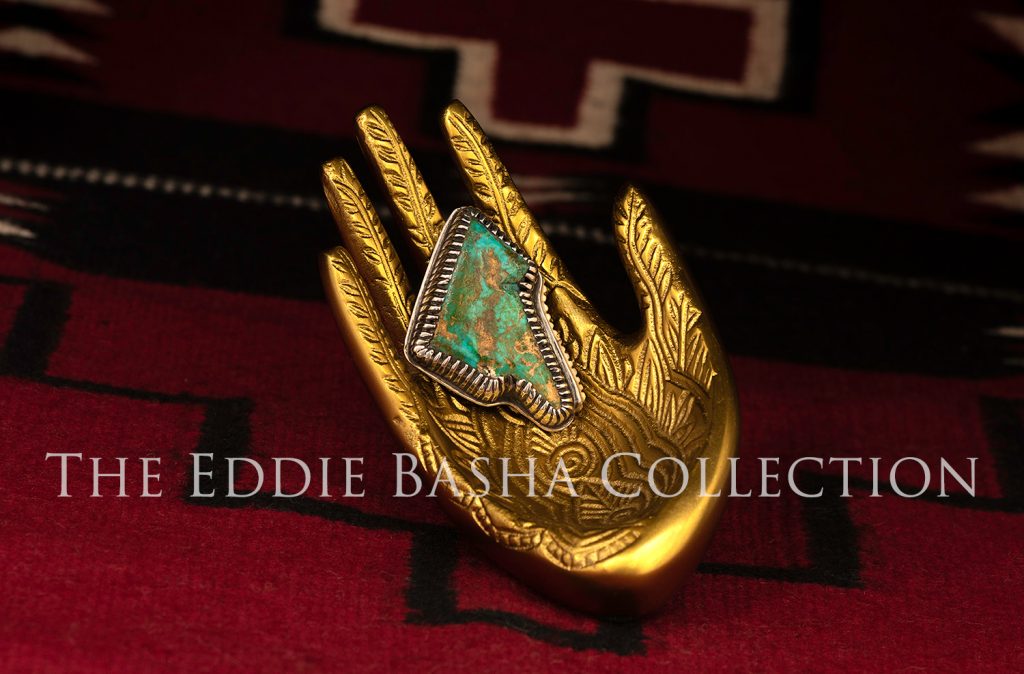 Eveli Sabatie (b.1940) | Silver/Turquoise
Eveli Sabatie (b.1940) | Silver/TurquoiseEveli Sabatie’s circuitous route to Tucson is an interesting one. After having been born in Algeria, raised in Morocco, educated in Paris at the Sorbonne, she found herself on Haight Street in San Francisco during the early 1970s. There she met three Hopi men who invited her to a ceremonial dance on the Third Mesa in Hotevilla, Arizona. Unfortunately, Eveli confused the dates and arrived early. By happenstance while tending to her laundry, she met famed jeweler Charles Loloma.
“Charles was very, very interested in people, and even more curious when the person was a lady,” Sabatie shared. “I got intrigued when he asked me, ‘What have you done in your life so far?’” She then told him she’d been drawing and sewing tapestries when he inquired, “Would you like to learn how to make jewelry?”
And there, on the Hopi reservation, Sabatie honed her skills alongside one of the finest innovators of his time. The similarities between her North African cultural roots and that of the Hopi, the surrounding mountains and landscapes, and the ceremonial drumbeats resonated within and she found her own voice and applied it to her work. After a four year apprenticeship and determined to spread her independent wings, she set up a studio for herself in Santa Fe and began showing her work at local galleries and in numerous others across the country.
In 1979, Sabatie moved to Tucson where she has lived ever since producing hundreds of works until arthritic and vision issues forced retirement from her craft in 1998. Currently, she remains a practicing yoga student and instructor.
Ring
Artist: Jewelry
Description:
Eveli Sabatie (b.1940) | Silver/Turquoise
Eveli Sabatie’s circuitous route to Tucson is an interesting one. After having been born in Algeria, raised in Morocco, educated in Paris at the Sorbonne, she found herself on Haight Street in San Francisco during the early 1970s. There she met three Hopi men who invited her to a ceremonial dance on the Third Mesa in Hotevilla, Arizona. Unfortunately, Eveli confused the dates and arrived early. By happenstance while tending to her laundry, she met famed jeweler Charles Loloma.
“Charles was very, very interested in people, and even more curious when the person was a lady,” Sabatie shared. “I got intrigued when he asked me, ‘What have you done in your life so far?’” She then told him she’d been drawing and sewing tapestries when he inquired, “Would you like to learn how to make jewelry?”
And there, on the Hopi reservation, Sabatie honed her skills alongside one of the finest innovators of his time. The similarities between her North African cultural roots and that of the Hopi, the surrounding mountains and landscapes, and the ceremonial drumbeats resonated within and she found her own voice and applied it to her work. After a four year apprenticeship and determined to spread her independent wings, she set up a studio for herself in Santa Fe and began showing her work at local galleries and in numerous others across the country.
In 1979, Sabatie moved to Tucson where she has lived ever since producing hundreds of works until arthritic and vision issues forced retirement from her craft in 1998. Currently, she remains a practicing yoga student and instructor.
jewelryEveli Sabatie’s circuitous route to Tucson is an interesting one. After having been born in Algeria, raised in Morocco, educated in Paris at the Sorbonne, she found herself on Haight Street in San Francisco during the early 1970s. There she met three Hopi men who invited her to a ceremonial dance on the Third Mesa in Hotevilla, Arizona. Unfortunately, Eveli confused the dates and arrived early. By happenstance while tending to her laundry, she met famed jeweler Charles Loloma.
“Charles was very, very interested in people, and even more curious when the person was a lady,” Sabatie shared. “I got intrigued when he asked me, ‘What have you done in your life so far?’” She then told him she’d been drawing and sewing tapestries when he inquired, “Would you like to learn how to make jewelry?”
And there, on the Hopi reservation, Sabatie honed her skills alongside one of the finest innovators of his time. The similarities between her North African cultural roots and that of the Hopi, the surrounding mountains and landscapes, and the ceremonial drumbeats resonated within and she found her own voice and applied it to her work. After a four year apprenticeship and determined to spread her independent wings, she set up a studio for herself in Santa Fe and began showing her work at local galleries and in numerous others across the country.
In 1979, Sabatie moved to Tucson where she has lived ever since producing hundreds of works until arthritic and vision issues forced retirement from her craft in 1998. Currently, she remains a practicing yoga student and instructor.
 Terry & Joe Reano | Necklace (1996) | 15 x 1.3
Terry & Joe Reano | Necklace (1996) | 15 x 1.3Terry and Joe Reano are among the premiere bead makers of Santo Domingo. Having both grown up there, Terry learned to make these beads as a child, and Joe has served on the Pueblo council. Their joint fame is certainly because every single bead of theirs is always made entirely by hand, the traditional way.
The husband-and-wife team of Joe B. and Terry Reano are among the few Pueblo artists who still make beads completely by hand, without using power tools. Both learned these techniques from their parents and have passed the tradition on to their children.
Carico Lake Turquoise (5 Strand) w/ Silver Cone Clasp
Artist: Jewelry
Description:
Terry & Joe Reano | Necklace (1996) | 15 x 1.3
Terry and Joe Reano are among the premiere bead makers of Santo Domingo. Having both grown up there, Terry learned to make these beads as a child, and Joe has served on the Pueblo council. Their joint fame is certainly because every single bead of theirs is always made entirely by hand, the traditional way.
The husband-and-wife team of Joe B. and Terry Reano are among the few Pueblo artists who still make beads completely by hand, without using power tools. Both learned these techniques from their parents and have passed the tradition on to their children.
jewelryTerry and Joe Reano are among the premiere bead makers of Santo Domingo. Having both grown up there, Terry learned to make these beads as a child, and Joe has served on the Pueblo council. Their joint fame is certainly because every single bead of theirs is always made entirely by hand, the traditional way.
The husband-and-wife team of Joe B. and Terry Reano are among the few Pueblo artists who still make beads completely by hand, without using power tools. Both learned these techniques from their parents and have passed the tradition on to their children.
 Denise Wallace (b.1957) | Fossilized Ivory/Sterling Silver (1988) | 1 ½”h x 1”w
Denise Wallace (b.1957) | Fossilized Ivory/Sterling Silver (1988) | 1 ½”h x 1”w“Technically astounding, aesthetically beautiful and culturally important. These are just some of the ways in which Denise Wallace’s jewelry can be described. Inspired by the stories of her Chugach Aleut ancestors, her unique creations have made her one of the best-known Alaska Native jewelers of our time. (Featured on the left in this image are a pair of Denise’s scrimshawed, fossilized ivory and sterling silver earrings, circa 1988.)
Wallace began her artistic journey as a student at the Institute of American Indian Arts in Santa Fe, New Mexico in the late seventies. After graduating, she and her husband Samuel remained in Santa Fe creating and selling work from their studio and gallery for twenty years. In 1999, they moved to the tropics of Hawaii where their collaborations continued until Samuel’s passing in 2010.”
Earrings
Artist: Jewelry
Description:
Denise Wallace (b.1957) | Fossilized Ivory/Sterling Silver (1988) | 1 ½”h x 1”w
“Technically astounding, aesthetically beautiful and culturally important. These are just some of the ways in which Denise Wallace’s jewelry can be described. Inspired by the stories of her Chugach Aleut ancestors, her unique creations have made her one of the best-known Alaska Native jewelers of our time. (Featured on the left in this image are a pair of Denise’s scrimshawed, fossilized ivory and sterling silver earrings, circa 1988.)
Wallace began her artistic journey as a student at the Institute of American Indian Arts in Santa Fe, New Mexico in the late seventies. After graduating, she and her husband Samuel remained in Santa Fe creating and selling work from their studio and gallery for twenty years. In 1999, they moved to the tropics of Hawaii where their collaborations continued until Samuel’s passing in 2010.”
jewelry“Technically astounding, aesthetically beautiful and culturally important. These are just some of the ways in which Denise Wallace’s jewelry can be described. Inspired by the stories of her Chugach Aleut ancestors, her unique creations have made her one of the best-known Alaska Native jewelers of our time. (Featured on the left in this image are a pair of Denise’s scrimshawed, fossilized ivory and sterling silver earrings, circa 1988.)
Wallace began her artistic journey as a student at the Institute of American Indian Arts in Santa Fe, New Mexico in the late seventies. After graduating, she and her husband Samuel remained in Santa Fe creating and selling work from their studio and gallery for twenty years. In 1999, they moved to the tropics of Hawaii where their collaborations continued until Samuel’s passing in 2010.”

Billy Betoney | Silver/Leather | 2”h x 6”w (lower left)
Unidentifed Silversmith | Silver/Leather | 2”h x 5 ¼”w (upper right)
The lower left belt buckle is a Billy Betoney original masterwork. Billy learned silversmithing during the 1970s from his wife Betty. Perhaps it was the art education he received in his youth that rendered him a natural in this new medium or perhaps it was his instructor. Either way, Billy and Betty are a perfect fit as are their talents.
With experience under his belt, Billy’s designs became more visionary. By utilizing some of the design elements of his mother’s rugs, he would custom cut and form silver strips into the desired shapes he needed. After five unsuccessful vendor entry attempts to Santa Fe Indian Market, a relative shared his booth with Billy in 1989. That very same year he won the prestigious award “Most Creative Design – Any Class.” Thereafter he continued to win various awards consecutively.
Unfortunately, the buckle on the upper right, though artisan hallmark stamped, is the work of an unidentified silversmith.
Navajo Belt Buckles
Artist: Jewelry
Description:
Billy Betoney | Silver/Leather | 2”h x 6”w (lower left)
Unidentifed Silversmith | Silver/Leather | 2”h x 5 ¼”w (upper right)
The lower left belt buckle is a Billy Betoney original masterwork. Billy learned silversmithing during the 1970s from his wife Betty. Perhaps it was the art education he received in his youth that rendered him a natural in this new medium or perhaps it was his instructor. Either way, Billy and Betty are a perfect fit as are their talents.
With experience under his belt, Billy’s designs became more visionary. By utilizing some of the design elements of his mother’s rugs, he would custom cut and form silver strips into the desired shapes he needed. After five unsuccessful vendor entry attempts to Santa Fe Indian Market, a relative shared his booth with Billy in 1989. That very same year he won the prestigious award “Most Creative Design – Any Class.” Thereafter he continued to win various awards consecutively.
Unfortunately, the buckle on the upper right, though artisan hallmark stamped, is the work of an unidentified silversmith.
jewelryBilly Betoney | Silver/Leather | 2”h x 6”w (lower left)
Unidentifed Silversmith | Silver/Leather | 2”h x 5 ¼”w (upper right)
The lower left belt buckle is a Billy Betoney original masterwork. Billy learned silversmithing during the 1970s from his wife Betty. Perhaps it was the art education he received in his youth that rendered him a natural in this new medium or perhaps it was his instructor. Either way, Billy and Betty are a perfect fit as are their talents.
With experience under his belt, Billy’s designs became more visionary. By utilizing some of the design elements of his mother’s rugs, he would custom cut and form silver strips into the desired shapes he needed. After five unsuccessful vendor entry attempts to Santa Fe Indian Market, a relative shared his booth with Billy in 1989. That very same year he won the prestigious award “Most Creative Design – Any Class.” Thereafter he continued to win various awards consecutively.
Unfortunately, the buckle on the upper right, though artisan hallmark stamped, is the work of an unidentified silversmith.
